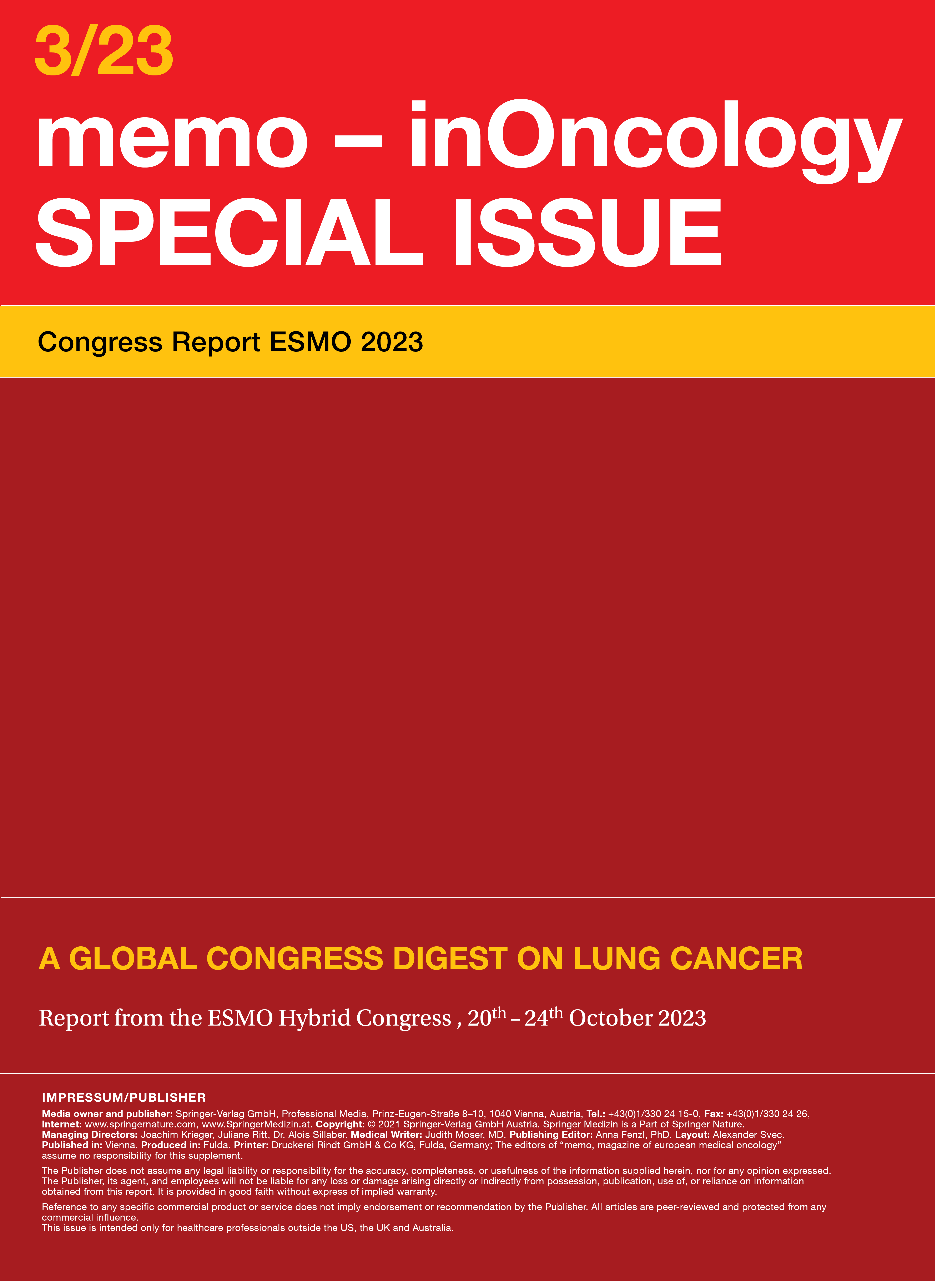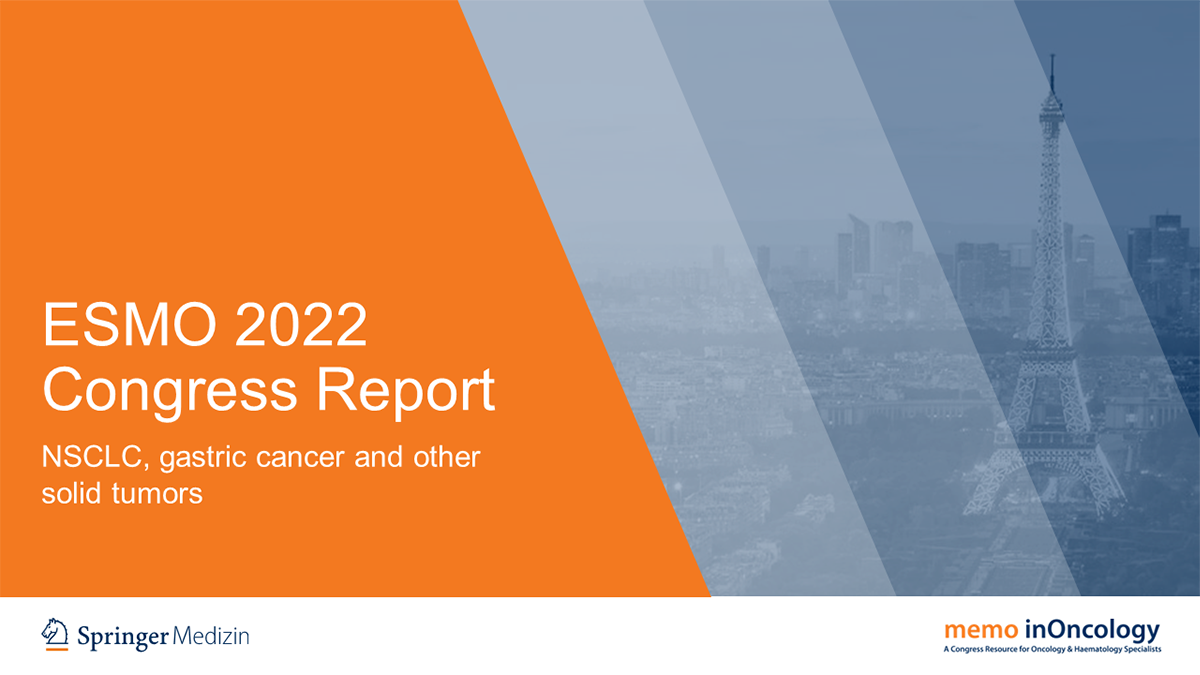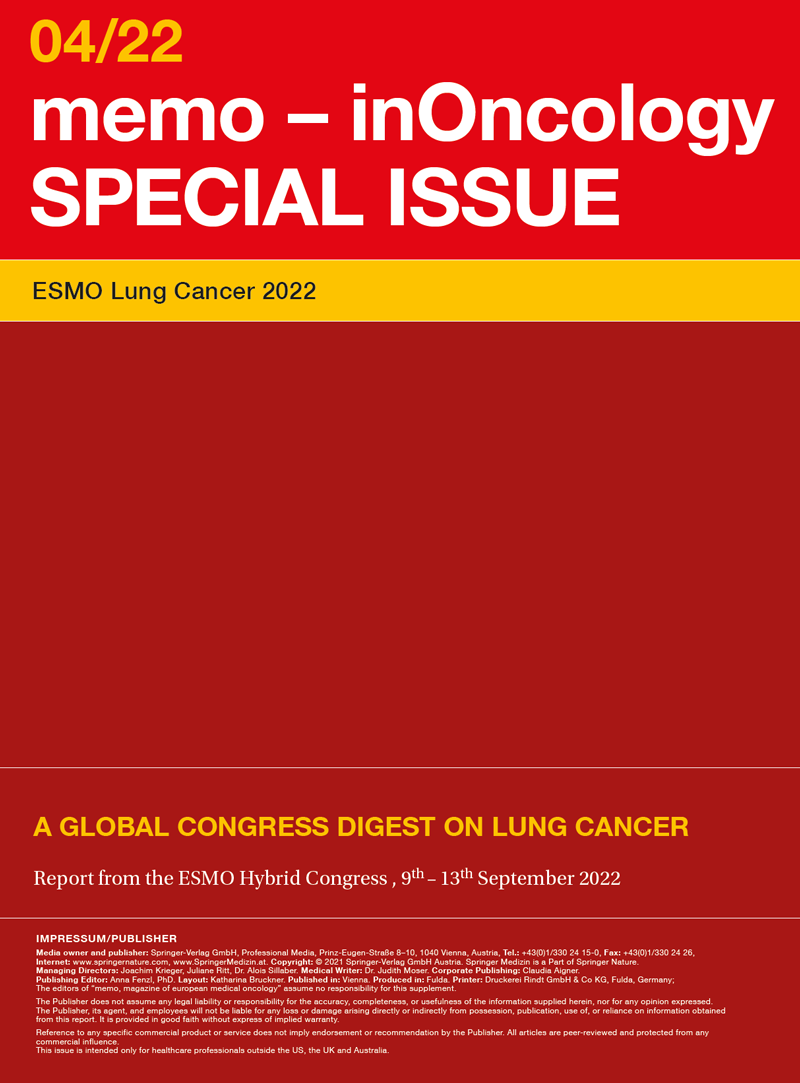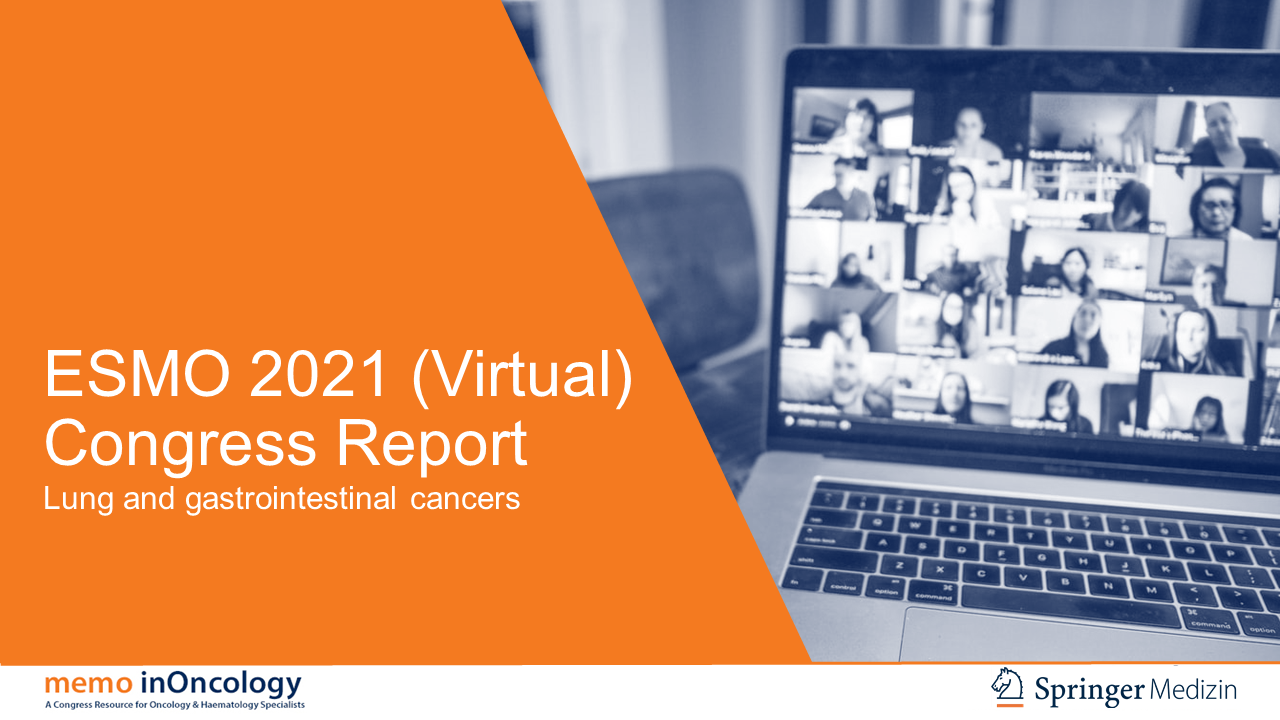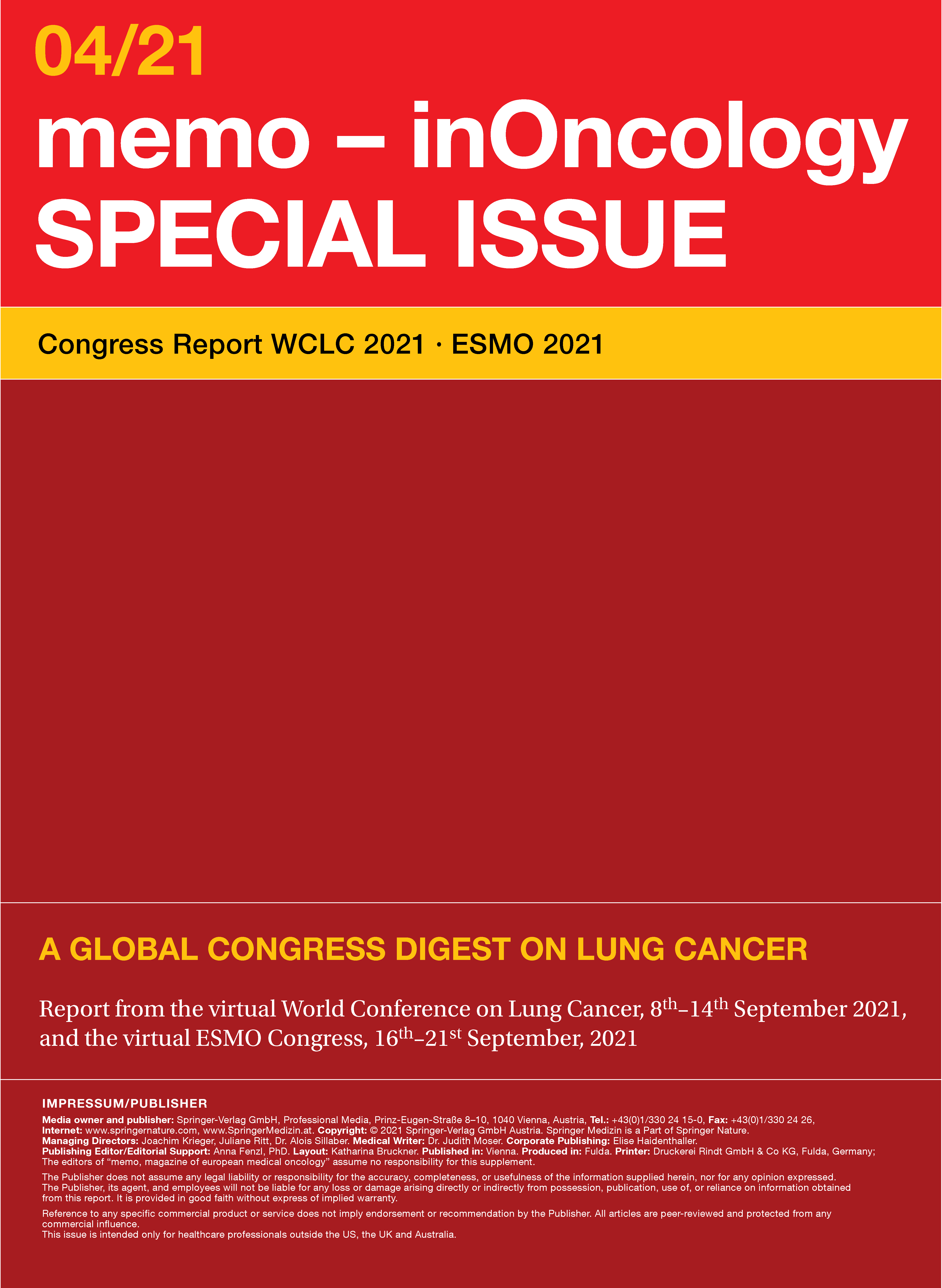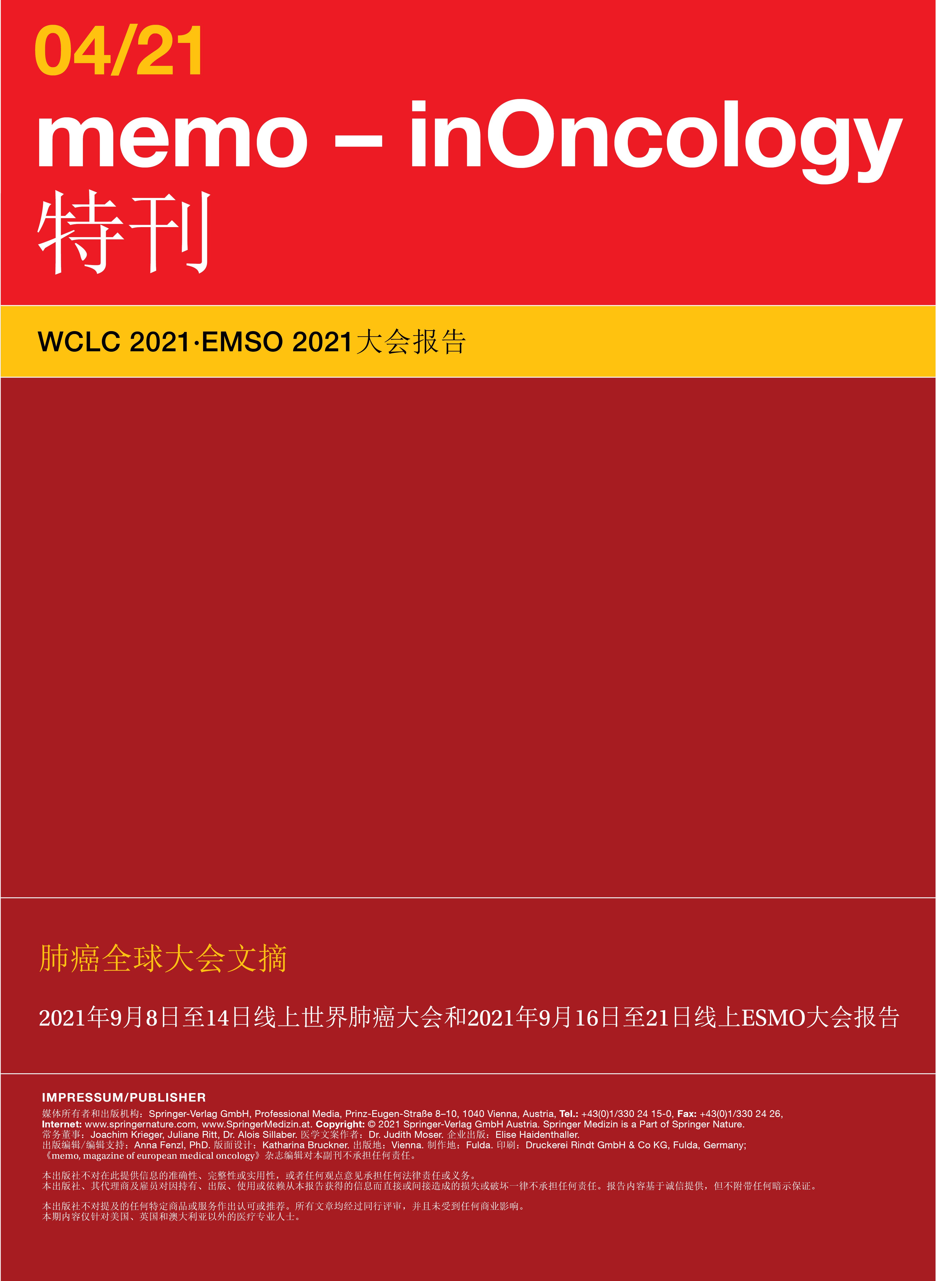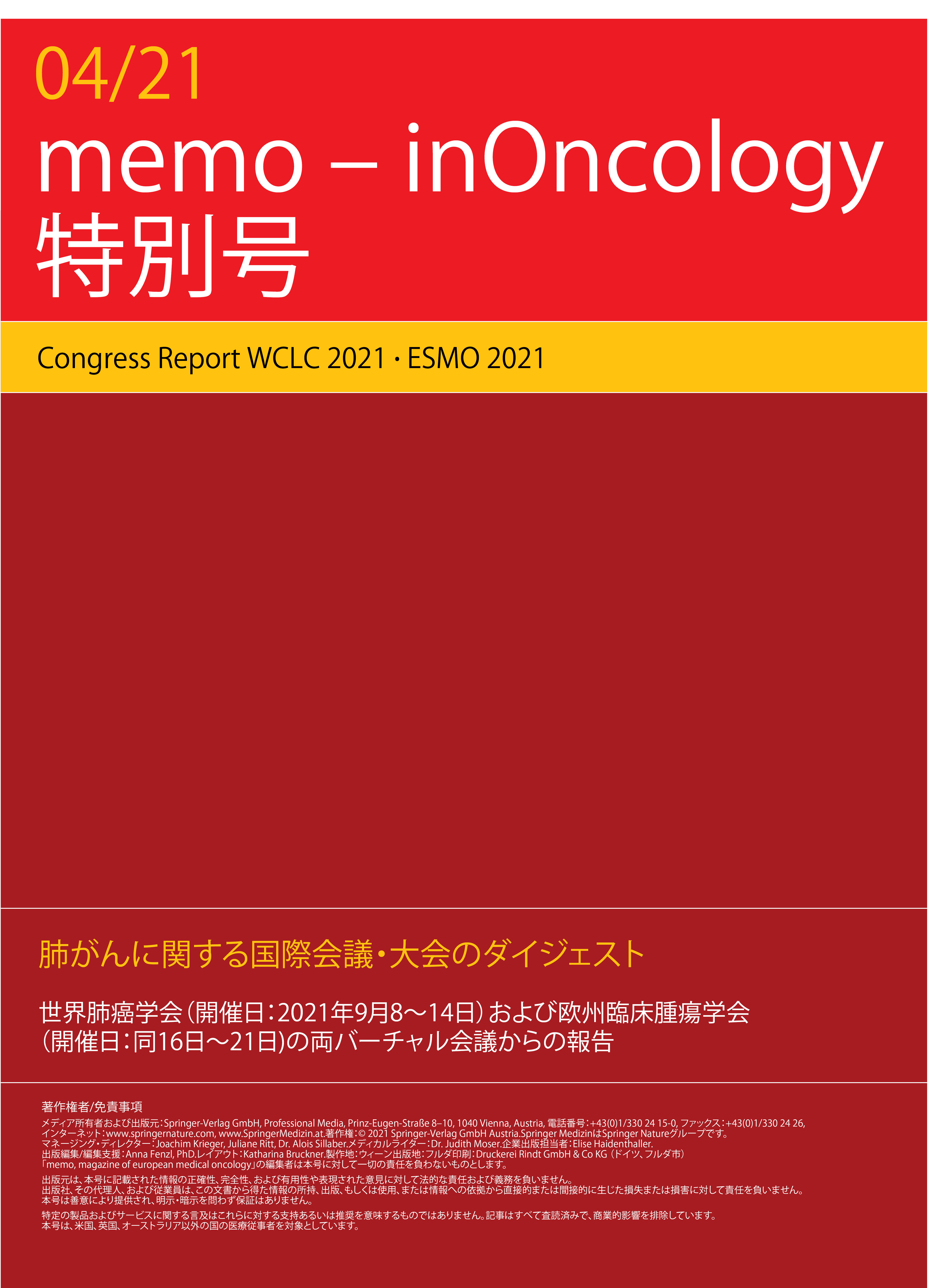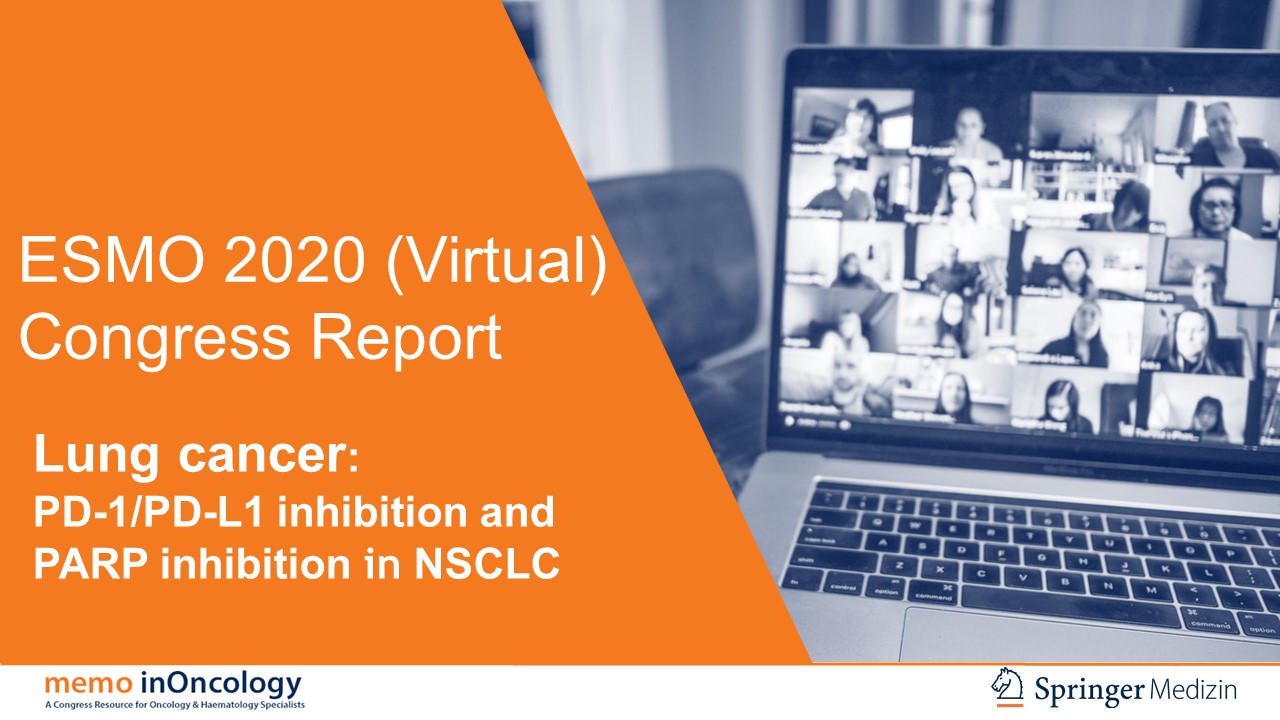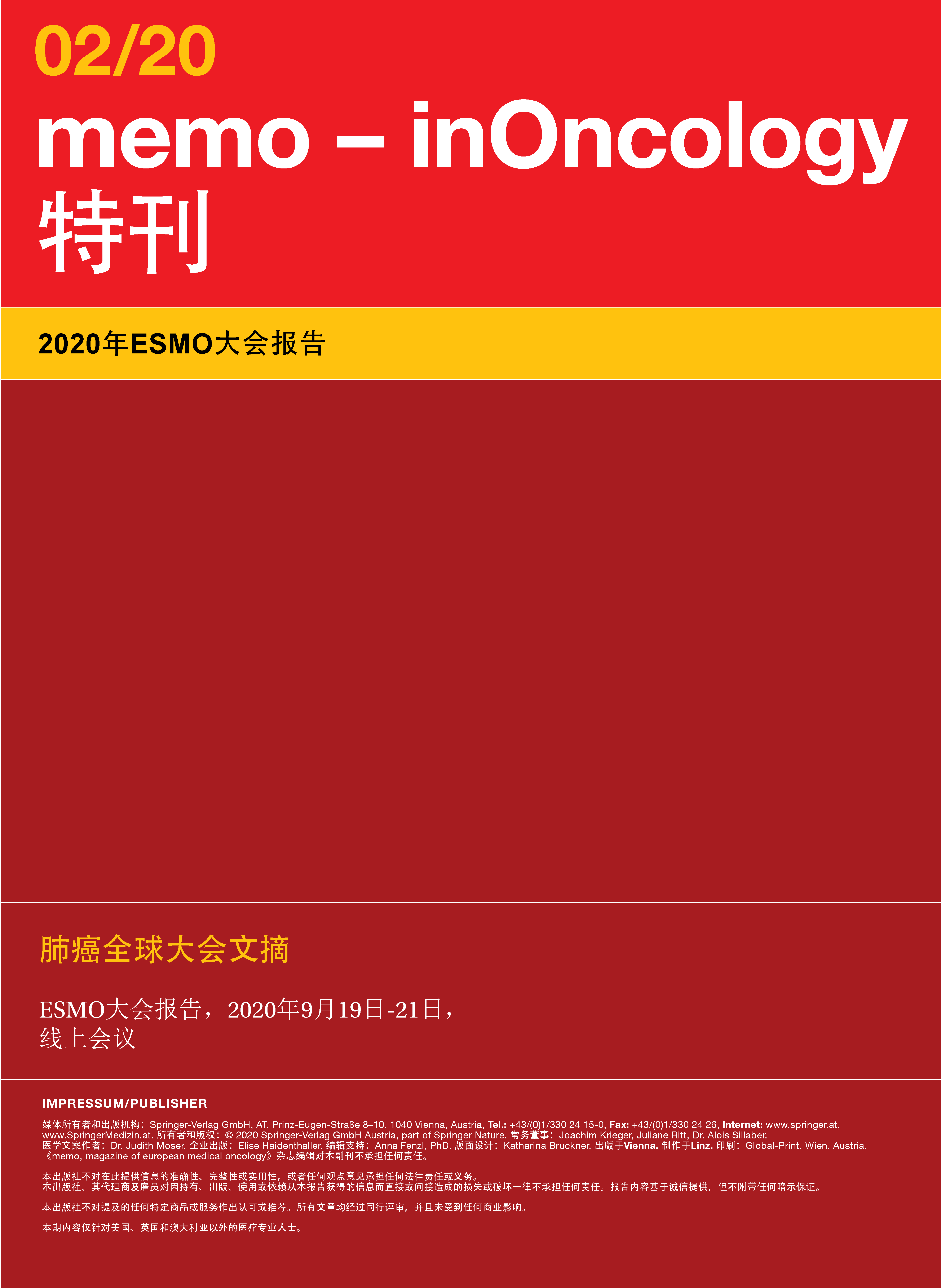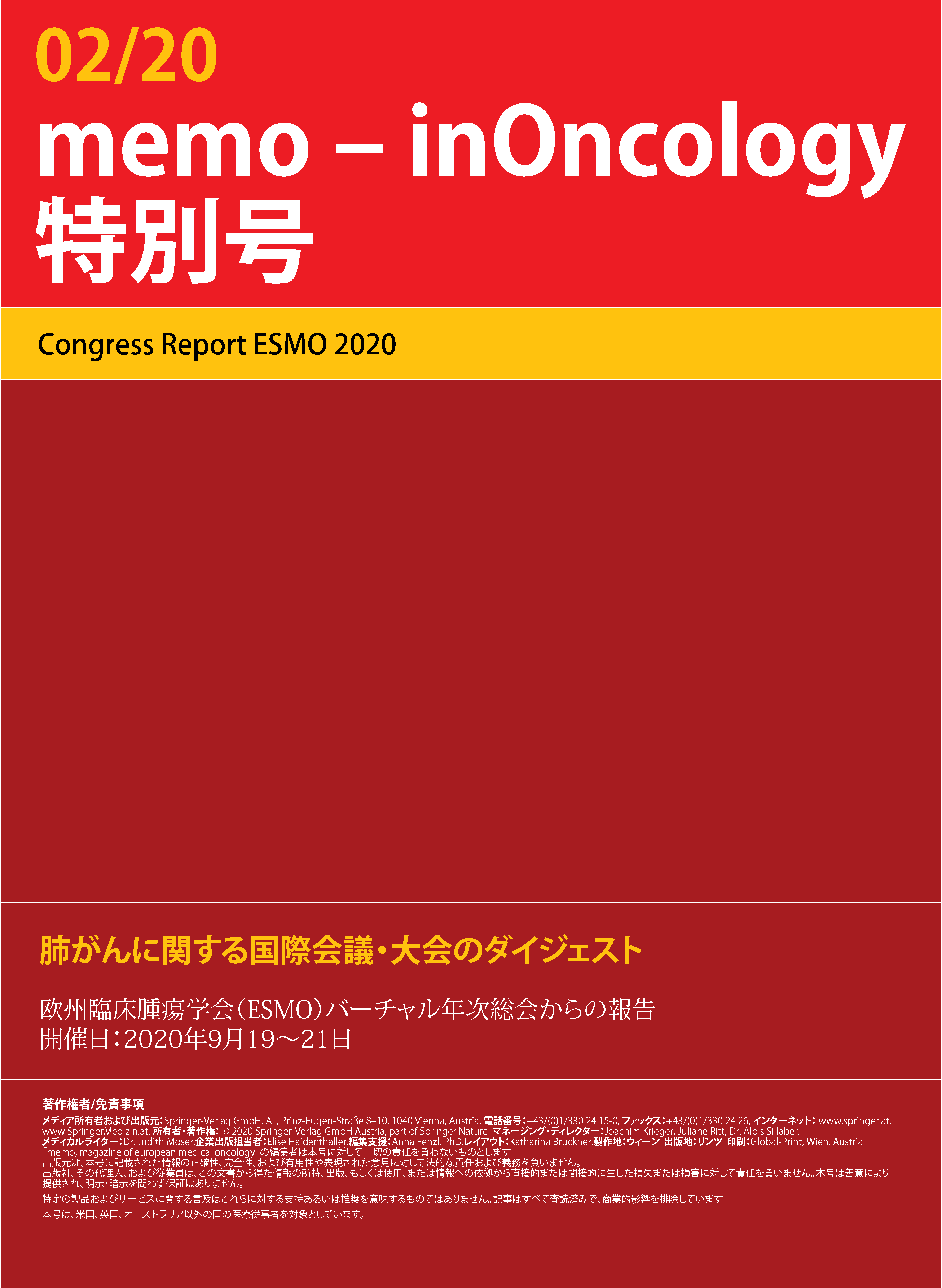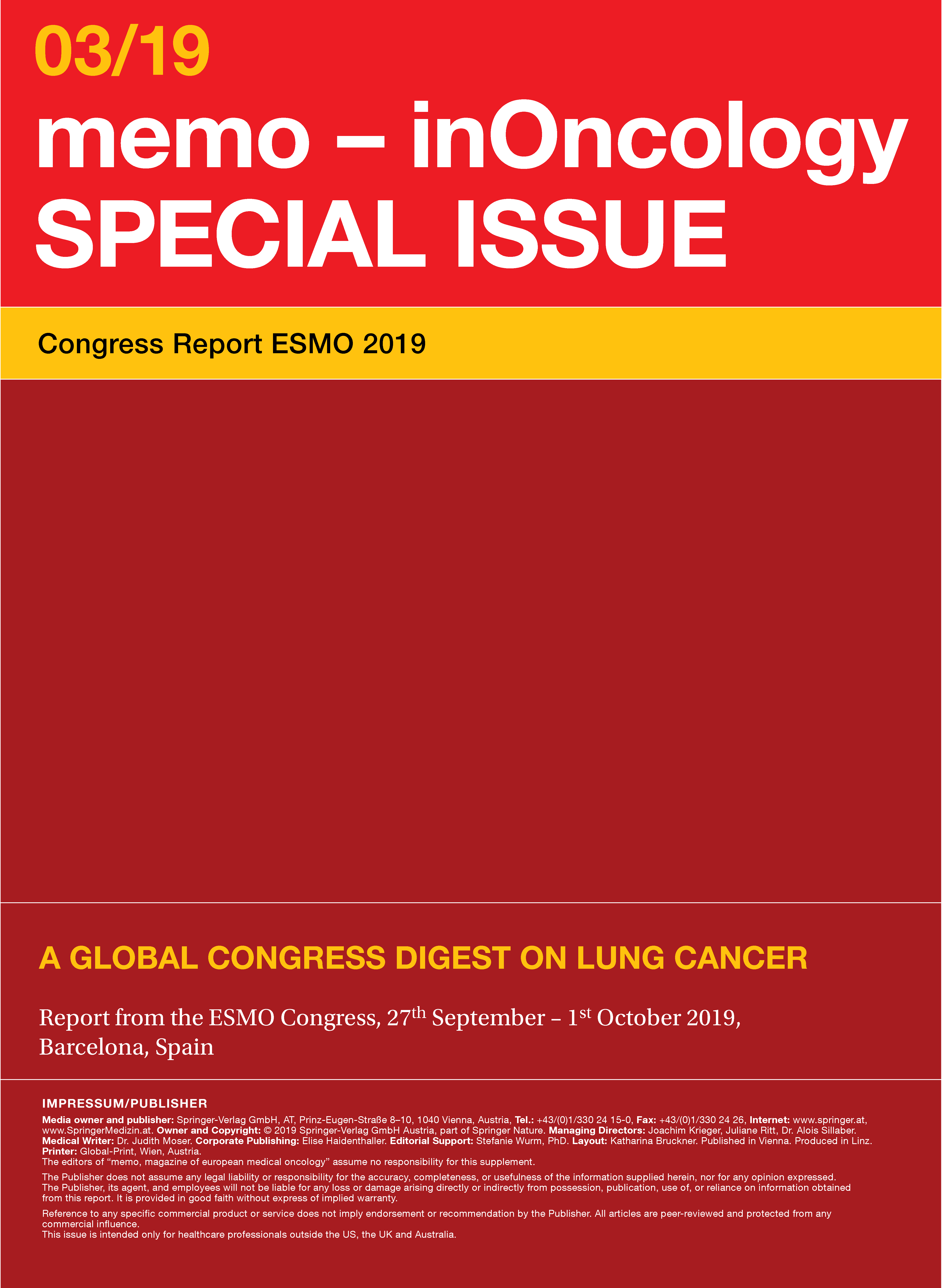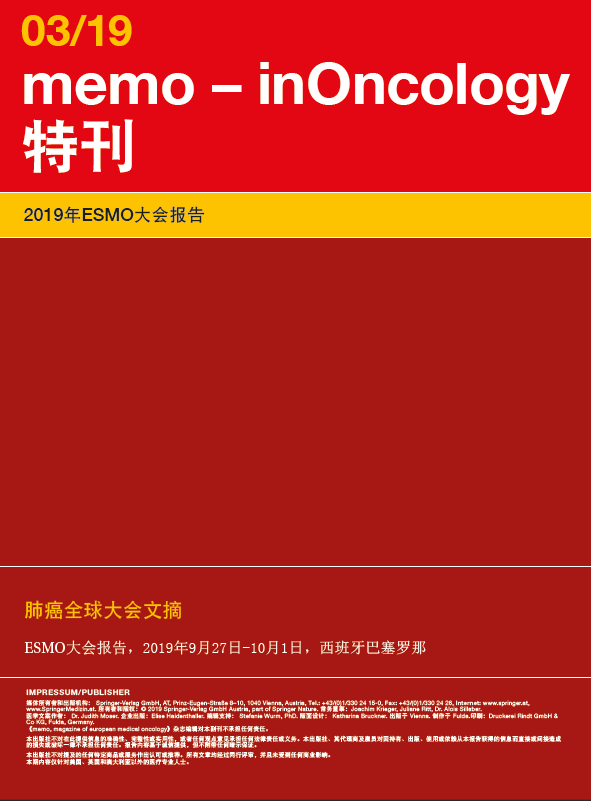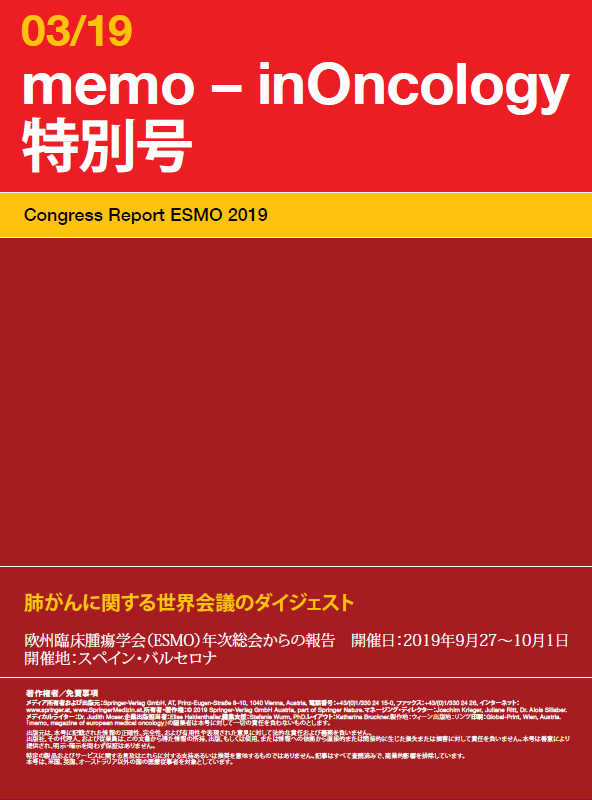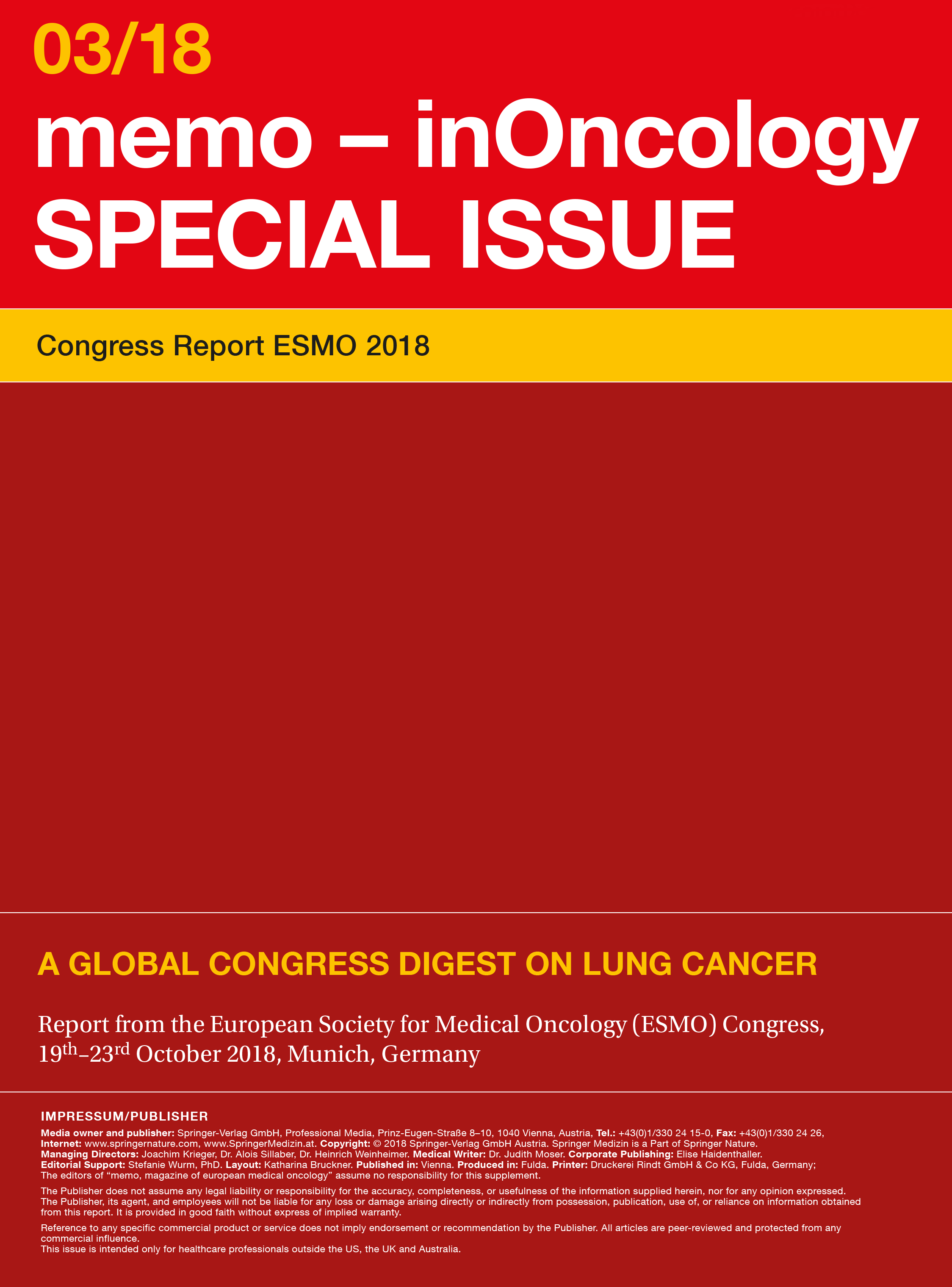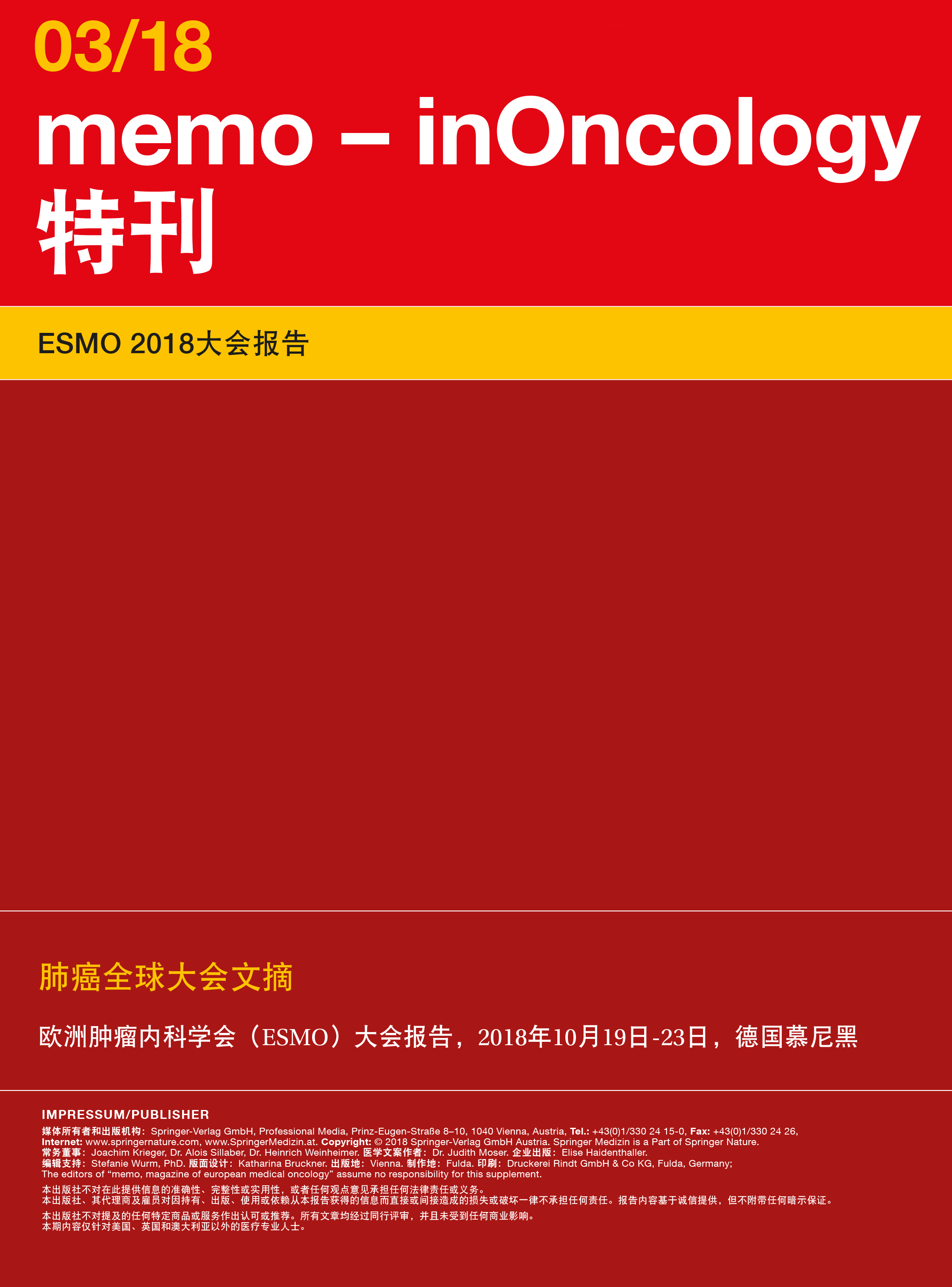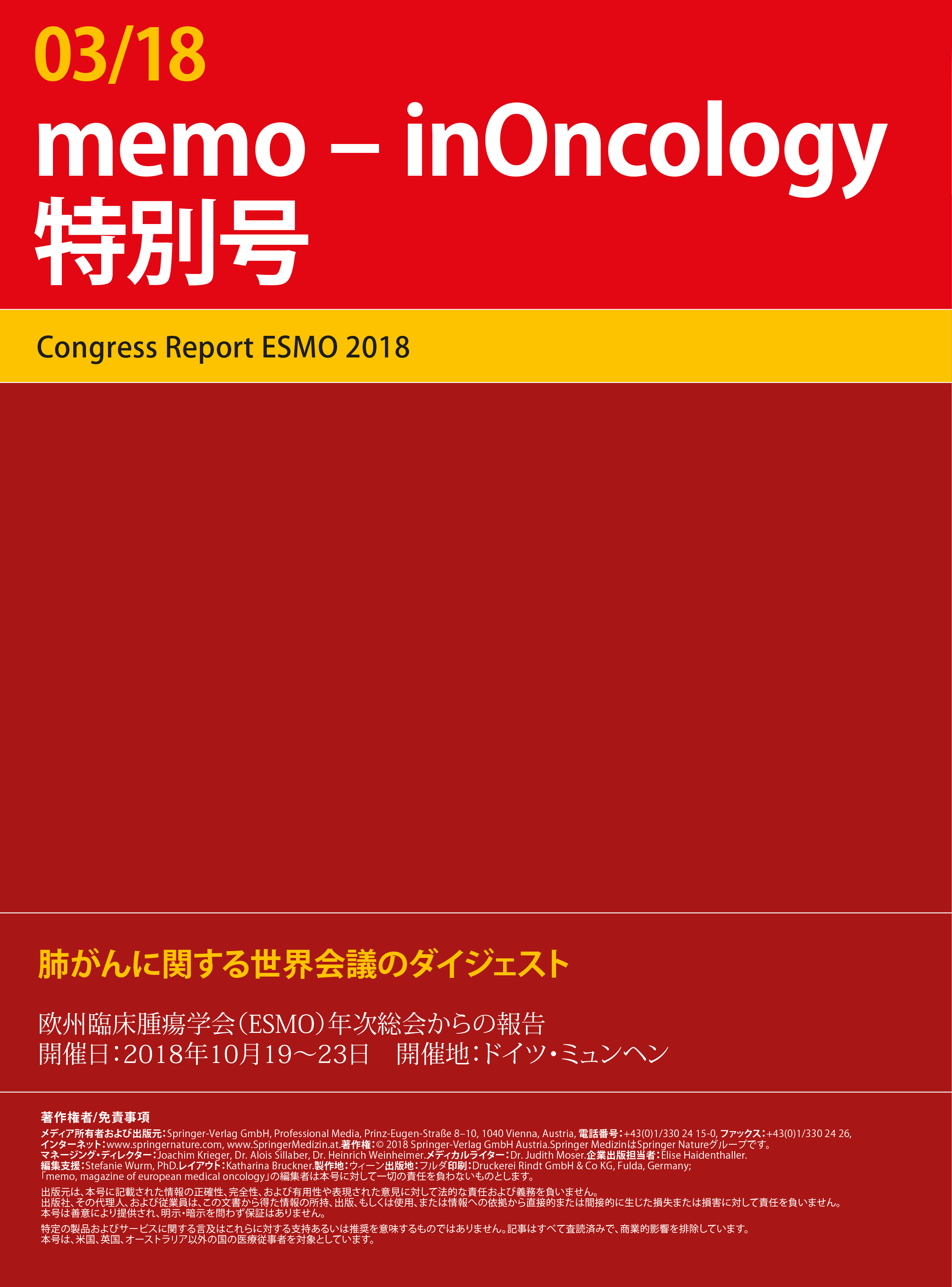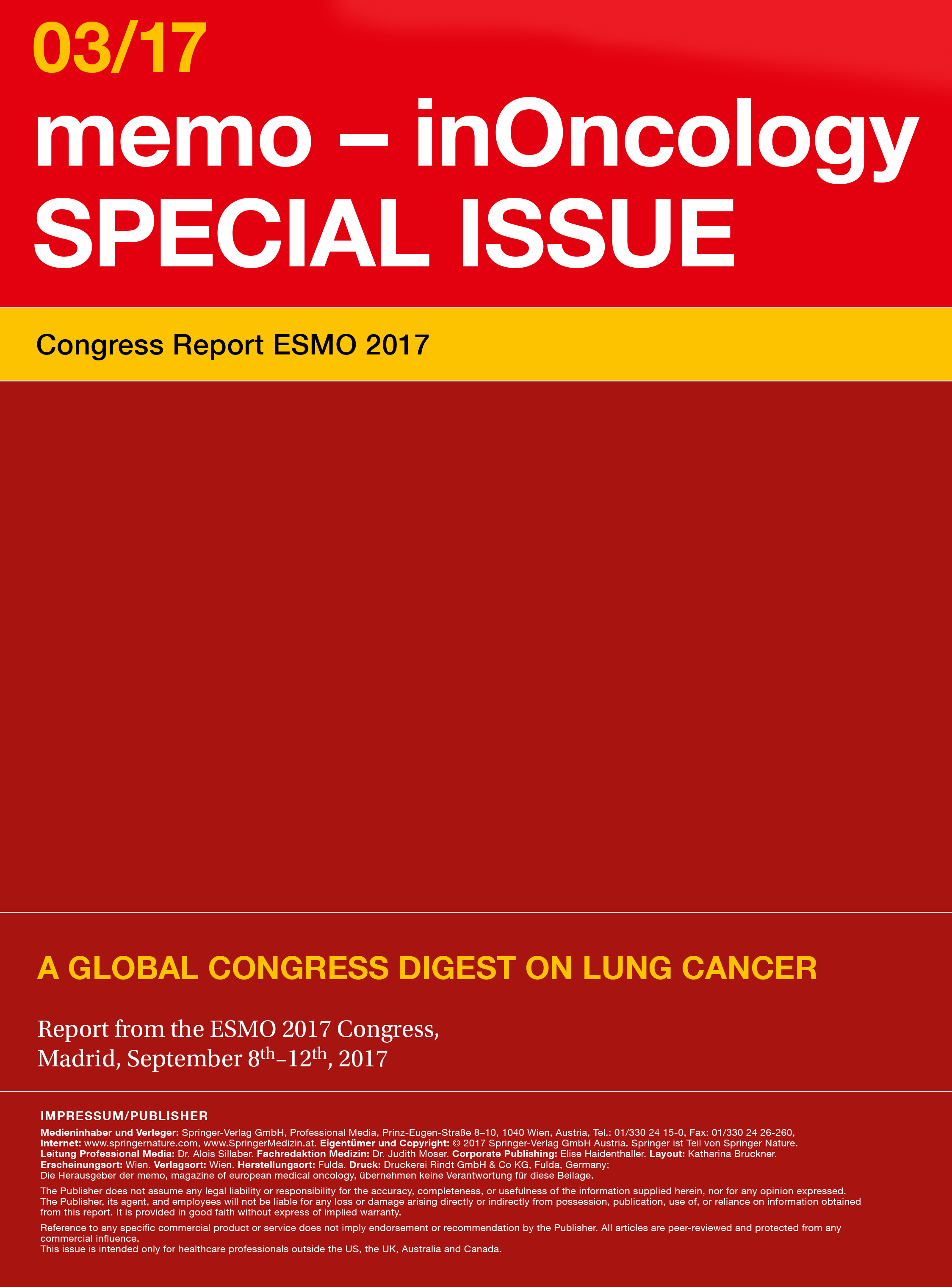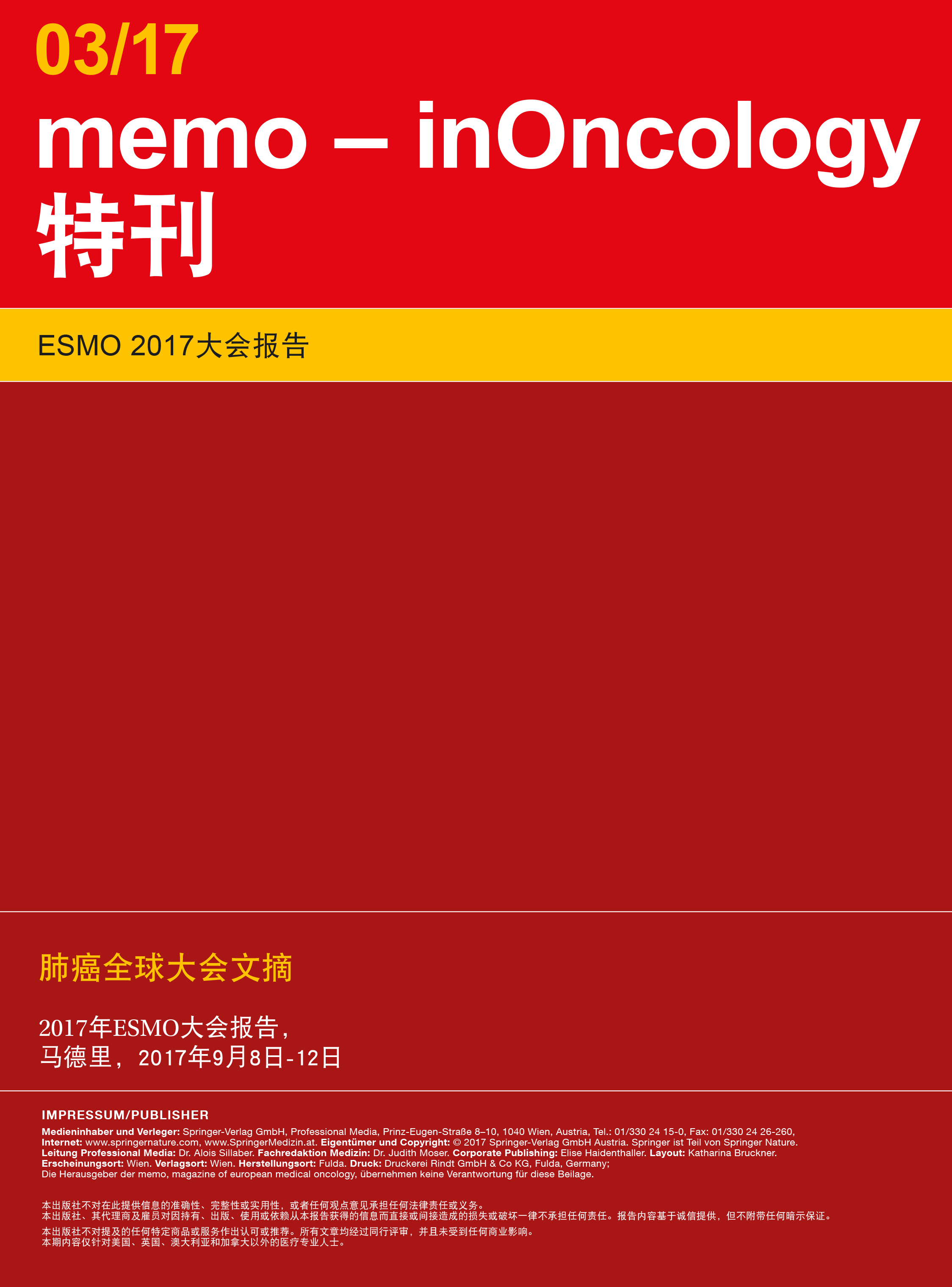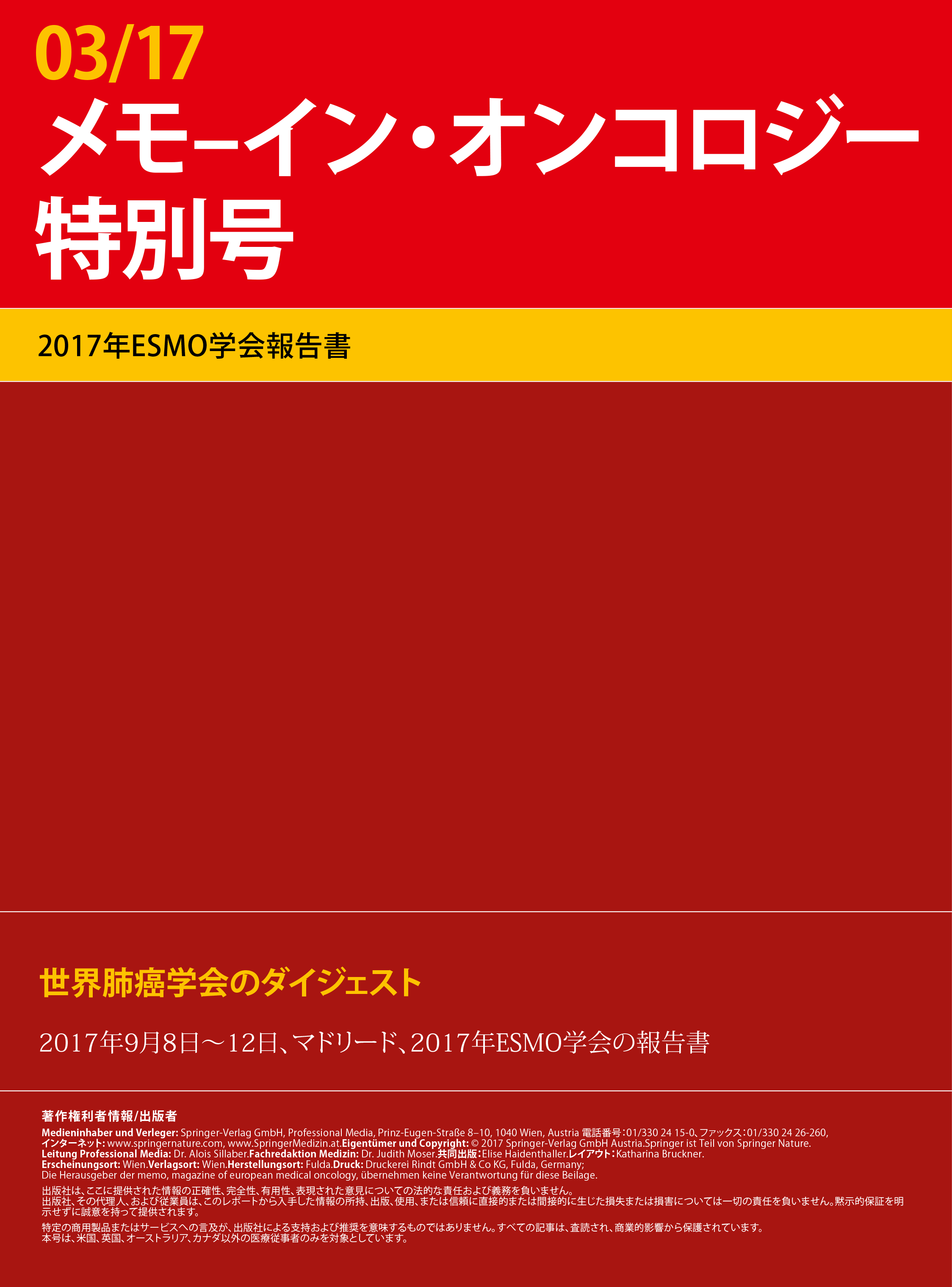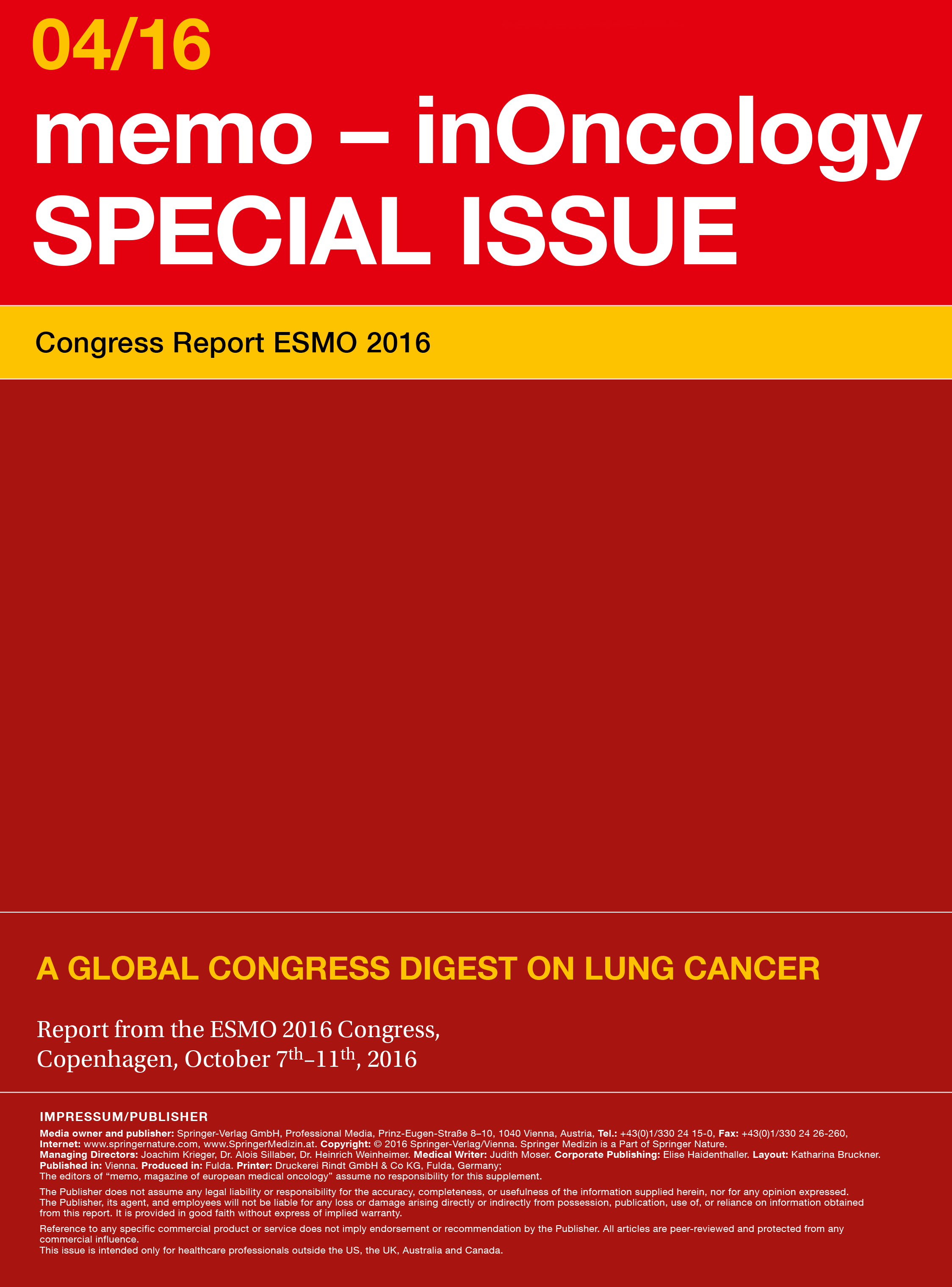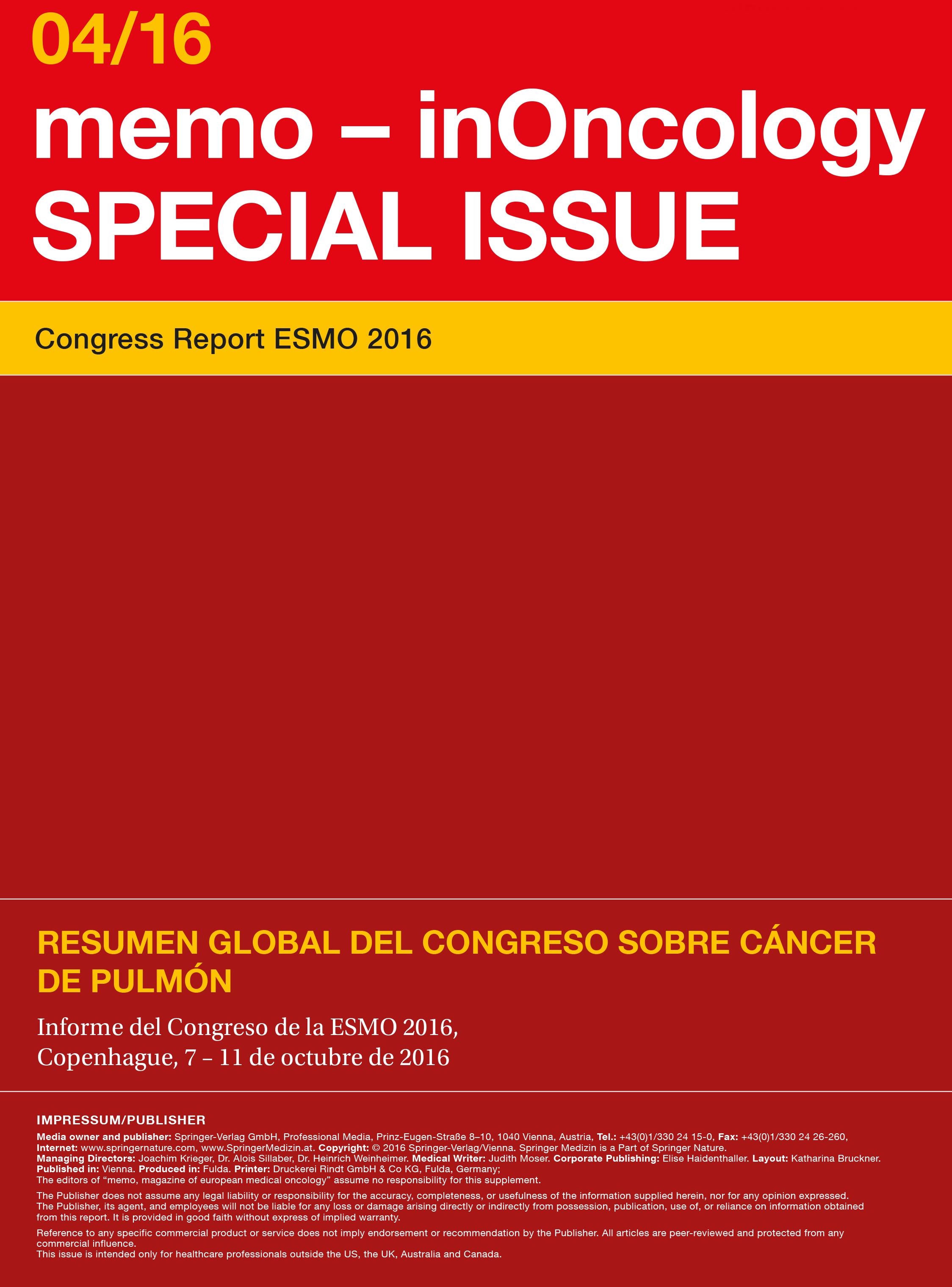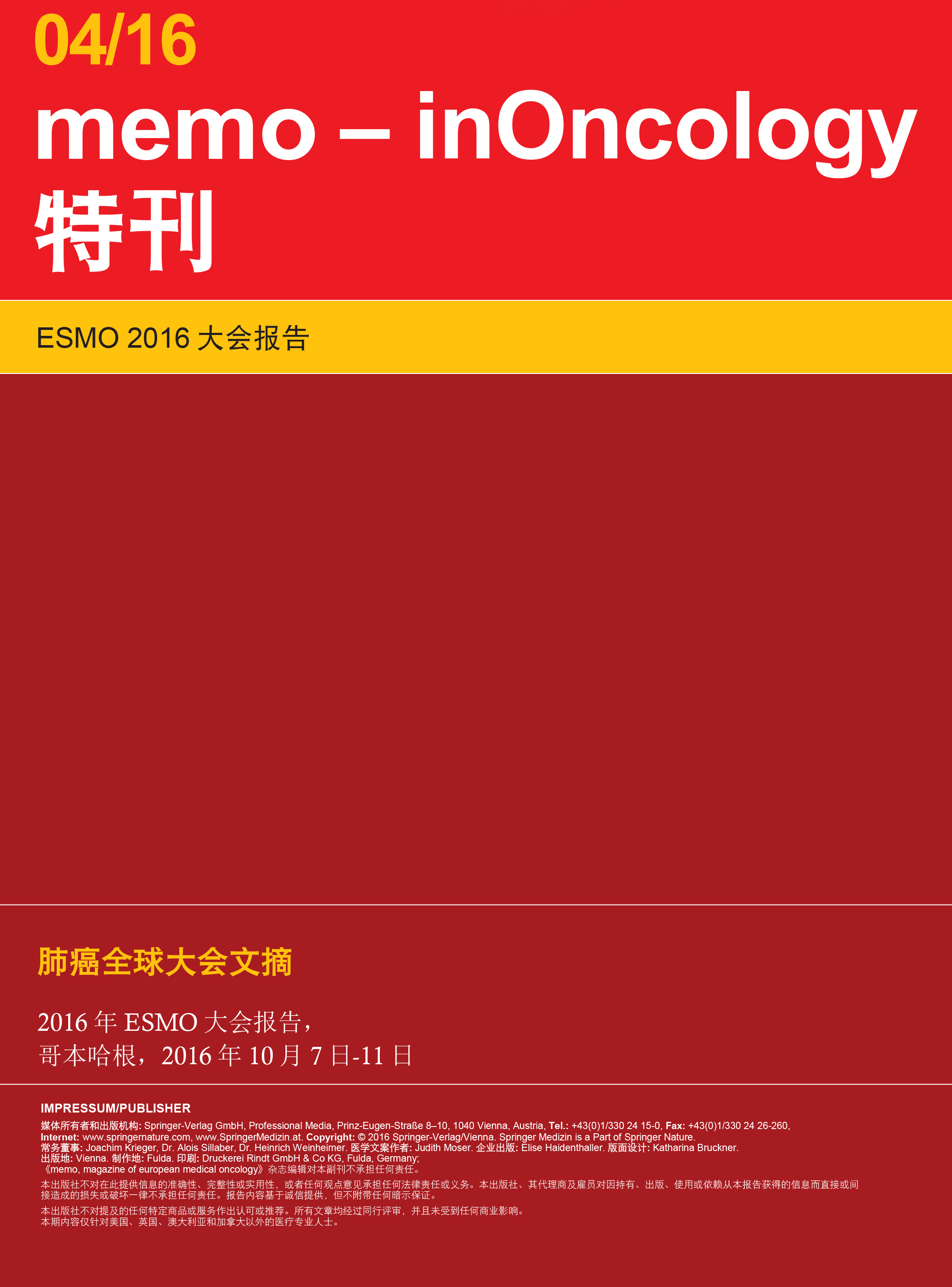ESMO 2023 Lung Cancer – hybrid, Madrid
Lecture Board: Maximilian Hochmair, MD
Medical Writer: Judith Moser, MD
Publishing Editor: Anna Fenzl, PhD
Preface – ESMO Lung Cancer 2023
Preface – ESMO Lung Cancer 2023 © private – Paul Baas, MD, PhD, Department of Thoracic Oncology, Netherlands Cancer Institute, Amsterdam, Netherlands Dear colleagues,It is a pleasure to present you the memo inOncology 2023.
ALK-targeted adjuvant treatment and perioperative immunotherapy
ALK-targeted adjuvant treatment and perioperative immunotherapy Approximately 30 % to 40 % of patients with non–small-cell lung cancer (NSCLC) are diagnosed with resectable disease [1, 2]. Depending on the stage, the risk of disease recurrence remains high in spite of treatment [3], which calls for more effective strategies.
Innovative agents directed against RET, Trop-2, KRASG12C and HER2
Innovative agents directed against RET, Trop-2, KRASG12C and HER2 Superiority of selpercatinib in RET-positive disease The highly selective and potent RET kinase inhibitor selpercatinib has been implemented in the treatment of lung cancer harboring RET gene fusions. At the same time, the combination of platinum, pemetrexed and pembrolizumab is an established first-line standard of care for patients without EGFR or ALK alterations.
EGFR-mutated NSCLC: practice-changing results and other notable findings
EGFR-mutated NSCLC: practice-changing results and other notable findings MARIPOSA: first-line amivantamab plus lazertinib In the setting of EGFR-mutated NSCLC, the third-generation EGFR TKI osimertinib is the current first-line standard of care, although eventual progression is virtually inevitable. Secondary EGFR and MET alterations have been found to account for 25 % to 50 % of cases of resistance [1-3].
Immunotherapy combinations in advanced-stage disease
Immunotherapy combinations in advanced-stage disease As is known, immune checkpoint inhibition plays only a limited role after failure of EGFR- or ALK-targeted treatment in patients with advanced NSCLC; this applies to both monotherapy and combinations with chemotherapy as demonstrated by the CheckMate 722 and KEYNOTE-789 trials [1, 2].
Small-cell lung cancer: insights and new treatment options centering around DLL3
Small-cell lung cancer: insights and new treatment options centering around DLL3 Target with prognostic and predictive value The cell surface protein delta-like-ligand 3 (DLL3) is an emerging therapeutic target in neuroendocrine tumors and neuroendocrine carcinomas such as small-cell lung cancer (SCLC).
EXPERT VIDEOS
All video interviews from ESMO Lung Cancer 2023
James R. M. Black provides an overview of the potential of ctDNA in pre-operative disease stratification for early lung cancer by highlighting data from an ultra-sensitive and specific ctDNA approach. Considering the challenges of comprehensive tissue sampling and that subclones may evade tumor biopsy detection due to undersampling of metastatic sites at relapse, he finally discusses what insights ctDNA-based methods could provide into the process of metastasis spread.
Sebastian Kobold discusses the growing interest in using CAR-T cell therapy as an innovative approach to treat solid tumors in the future, as well as T cell receptor T cell therapy. Although there are still some hurdles to overcome, he discusses what remarkable developments can be expected in this field in the coming years.
Gerrina Ruiter explains the limitations of previous HER2 agents tested in solid tumors while highlighting the encouraging preliminary results of the BEAMION Lung-1 trial of zongertinib in HER2–mutant solid tumors. Lastly, she talks about the challenges of bispecific antibodies, which have recently shown robust efficacy in solid tumors.
Åslaug Helland summarizes the results from the NIPU trial combining UV1 vaccination and immunotherapy in the setting of malignant mesothelioma. Furthermore, she explains how study designs might be modified to expand treatment options in personalized medicine and explains which data could potentially be used as external comparator arms where randomized controlled trials might be unethical, or no defined standard treatment and/or too small patient groups are available.
David C. Currow highlights the encouraging results of two Phase 3 randomized trials that investigated a ghrelin antagonist to combat cachexia in NSCLC patients. He also provides an overview of the recent advancements in integrating palliative care for cancer patients, and addresses the ongoing challenges that we still face in terms of end-of-life care in everyday practice.
ESMO 2022 Lung Cancer – hybrid, Paris
Lecture Board: Maximilian Hochmair, MD; Wenhua Liang, MD; Charles Swanton, FRS, FMedSci
Medical Writer: Judith Moser, MD
Publishing Editor: Anna Fenzl, PhD
Preface – ESMO Lung Cancer 2022
Preface – ESMO Lung Cancer 2022 © ElainePerks2013 - Charles Swanton, MBBS, PhD, FRCP, FMedSci, FRS, Francis Crick Institute and UCL Hospitals, London, United Kingdom Dear Colleagues, At the ESMO Congress held in Paris, France, and virtually from 9th to 13th September 2022, practice-changing data and high-quality education attracted more than 29,300 participants from over 150 countries. The 1,912 abstracts reported at the conference included 76 late-breaking abstracts, and 11 abstracts were s
Treatment benefits and outcome determinants in (neo)adjuvant trials
Treatment benefits and outcome determinants in (neo)adjuvant trials ADAURA: study update The adjuvant use of the third-generation EGFR tyrosine kinase inhibitor (TKI) osimertinib is being explored in the phase III ADAURA study that includes almost 700 patients with completely resected stage IB, II, and IIIA, EGFR-mutant non-small-cell lung cancer (NSCLC), with or without adjuvant chemotherapy.
Targeted approaches in the first and later lines: KRASG12C, EGFR, HER2 & angiogenesis
Targeted approaches in the first and later lines: KRASG12C, EGFR, HER2 & angiogenesis The first-in-class, oral, irreversible KRASG12C inhibitor sotorasib has given rise to durable clinical benefits in patients with advanced KRASG12C-mutated NSCLC in the phase II CodeBreak 100 trial, with an objective response rate (ORR) and median progression-free survival (PFS) of 37.1 % and 6.8 months, respectively [1].
Updates on immunotherapy-based treatment of stage III/IV disease
Updates on immunotherapy-based treatment of stage III/IV disease IPSOS: atezolizumab in platinum-ineligible patients At least 40 % of patients with NSCLC have poor performance status (ECOG PS ≥ 2) and/or are elderly with multiple comorbidities and poor tolerance of treatment [1].
Air-pollution–induced lung cancer: defining a targetable link
Air-pollution–induced lung cancer: defining a targetable link The close association between air pollution and increased lung cancer risk has been known for decades, although causation remained unknown.
Benefits of lung cancer mass screening in China
Benefits of lung cancer mass screening in China The LUNG-CARE project presented by Liang et al. aimed to evaluate the outcome of mass lung cancer screening in a Chinese general population and to investigate risk factors to improve risk assessment for screening [1].
EXPERT VIDEOS
All video interviews from ESMO Lung Cancer 2022
Gérard Zalcman discusses recent findings regarding the duration of immune checkpoint inhibitor treatment in patients with NSCLC, expectations of checkpoint inhibitor therapy in the setting of unresectable malignant pleural mesothelioma and how the treatment of patients with malignant pleural mesothelioma might be further optimized based on molecular findings.
Marina Garassino comments on checkpoint inhibition in lung cancer patients with oncogenic drivers, highlights novel developing therapies in EGFR-mutant NSCLC patients with resistance to TKIs, summarizes the most relevant findings presented at ESMO 2022 in terms of the management of patients with previously untreated, metastatic non-squamous and squamous NSCLC without EGFR/ALK alterations as well as patients with extensive-stage small-cell lung cancer; and finally discusses how artificial intelligence can be used to predict the efficacy of immunotherapy in lung cancer patients.
Noemi Reguart outlines if EGFR-directed treatment in the setting of advanced NSCLC should be based on T790M monitoring in clinical practice, outlines recent insights gained in the negative CANOPY-A trail using the anti-IL-1β antibody canakinumab after resection of early-stage NSCLC and summarizes the current treatment landscape in Europe with respect to small-cell lung cancer.
ESMO 2021 Lung Cancer – virtual
Lecture Board: Alex A. Adjei, MD, PhD; Oliver Gautschi, MD; Maximilian Hochmair, MD
Medical Writer: Judith Moser, MD
Publishing Editor: Anna Fenzl, PhD
Preface
Preface – ESMO 2021 Alex A. Adjei, MD, PhD, Professor of Oncology and Pharmacology Mayo Clinic, Rochester, USA Recipient of the ESMO Lifetime Achievement Award 2021 Dear Colleagues, With the World Conference on Lung Cancer that took place on 8th–14th September 2021 and the ESMO Congress on 16th–21st September, two prestigious cancer congresses have offered a wealth of new preclinical and clinical information in the field of lung cancer.
Expansion of treatments and insights in the early-stage disease setting
Expansion of treatments and insights in the early-stage disease setting The management of patients with stage I-III non–small-cell lung cancer (NSCLC) is still characterized by a high unmet medical need as up to 60 % experience disease relapse despite treatment with curative intent [1].
Innovative and established agents across a range of targets
Innovative and established agents across a range of targets Anti-HER2 treatment DESTINY-Lung01: robust effects of T-DXd HER2 mutations constitute the predominant driver aberration in approximately 3 % of non-squamous NSCLC cases [1, 2].
Immunotherapy: boosting efficacy and overcoming resistance
Immunotherapy: boosting efficacy and overcoming resistance POSEIDON: durvalumab ± tremelimumab The global, randomized, open-label, phase III POSEIDON trial evaluated the PD-L1 inhibitor durvalumab with or without the anti-CTLA-4 antibody tremelimumab in addition to chemotherapy as a first-line strategy in the setting of metastatic NSCLC.
Small-cell lung cancer: on the road to improved efficacy and tolerability
Small-cell lung cancer: on the road to improved efficacy and tolerability ATLANTIS Lurbinectedin, a selective inhibitor of oncogenic transcription, has been approved at a dose of 3.2 mg/m2 Q3W for the treatment of patients with small-cell lung cancer (SCLC) showing disease progression on or after platinum-based chemotherapy in the US.
Malignant pleural mesothelioma: immunotherapy-based approaches in all treatment lines
Malignant pleural mesothelioma: immunotherapy-based approaches in all treatment lines Long-term results from CheckMate 743 The randomized phase III CheckMate 743 trial evaluated nivolumab 3 mg/kg Q2W plus ipilimumab 1 mg/kg Q6W for up to 2 years compared with cisplatin or carboplatin plus pemetrexed Q3W for 6 cycles as first-line treatment of patients with unresectable malignant pleural mesothelioma (MPM).
Gradual progress in the management of mesothelioma and thymoma
Gradual progress in the management of mesothelioma and thymoma Oliver Gautschi, MD, Luzerner Kantonsspital, Lucerne, Switzerland Which innovative strategies for the treatment of patients with unresectable malignant pleural mesothelioma you do deem promising? This is an important field where little progress has been made in the past.
ATALANTE-1: anti-cancer vaccination after IO failure
ATALANTE-1: anti-cancer vaccination after IO failure OSE-2101 is an anti-cancer vaccine with modified neoepitopes restricted to HLA-A2+ targeting the tumor-associated antigens CEA, p53, HER2, MAGE-2 and MAGE-3 that are frequently expressed in lung cancer [1].
DUBLIN-3: microtubule-binding agent plinabulin in later lines
DUBLIN-3: microtubule-binding agent plinabulin in later lines Patients with EGFR-wildtype, advanced NSCLC in the second or third treatment line represent a large population with limited treatment options.
序言
序言 Alex A. Adjei, MD, PhD 美国罗契斯特市梅约诊所肿瘤学和药理学教授 2021年ESMO终身成就奖获得者 亲爱的同事们, 世界肺癌大会和ESMO大会分别在2021年9月8日至14日和2021年9月16日至21日召开,这两个享负盛誉的癌症大会在肺癌领域提供了大量新的临床前信息和临床信息。
早期疾病环境中的治疗扩展和见解
早期疾病环境中的治疗扩展和见解 治疗I-III期非小细胞肺癌(NSCLC)患者的医疗需求仍远未得到满足,因为尽管进行了治愈性治疗,仍有高达60%的患者出现疾病复发[1]。
跨越一系列靶标的创新成熟药剂
跨越一系列靶标的创新成熟药剂 抗HER2治疗 DESTINY-Lung01:T-DXd的强大效果 在大约3%的非鳞状NSCLC病例中,HER2突变构成了主要的驱动畸变[1, 2]。
免疫疗法:提高疗效并克服耐药性
免疫疗法:提高疗效并克服耐药性 POSEIDON:度伐鲁单抗±曲美木单抗(tremelimumab) 全球、随机化、开放标签、III期POSEIDON试验评估了在有或没有抗CTLA-4抗体曲美木单抗时PD-L1抑制剂度伐鲁单抗外加化疗作为转移性NSCLC条件下的一线策略。在19个国家的153个地点,1,013名鳞状或非鳞状IV期NSCLC患者被随机分为三组。
小细胞肺癌:正在改善疗效和耐药性
小细胞肺癌:正在改善疗效和耐药性 ATLANTIS 芦比替定(lurbinectedin)是一种选择性致癌转录抑制剂,已在美国以3.2 mg/m2 Q3W的剂量被批准用于治疗在铂类化疗期间或之后疾病进展的小细胞肺癌(SCLC)患者。
恶性胸膜间皮瘤:在所有治疗线中的基于免疫疗法的方法
恶性胸膜间皮瘤:在所有治疗线中的基于免疫疗法的方法 CheckMate 743的长期结果 随机化III期CheckMate 743试验评估了作为不可切除的恶性胸膜间皮瘤(MPM)患者的一线治疗的3 mg/kg纳武单抗Q2W加1 mg/kg伊匹单抗Q6W持续最多2年与顺铂或卡铂加培美曲塞Q3W持续6个周期的对比。
间皮瘤和胸腺瘤治疗的逐步发展
间皮瘤和胸腺瘤治疗的逐步发展 Oliver Gautschi, MD, Luzerner Kantonsspital, Lucerne, Switzerland 您认为治疗不可切除恶性胸膜间皮瘤患者的哪些创新策略有前景? 这是一个重要的领域,但过去几乎没有取得任何进展。
ATALANTE-1:IO失败后的抗癌疫苗接种
ATALANTE-1:IO失败后的抗癌疫苗接种 OSE-2101是一种抗癌疫苗,具有仅限于HLA-A2+的修饰新表位,靶向在肺癌中经常表达的肿瘤相关抗原CEA、p53、HER2、MAGE-2和MAGE-3 [1]。
DUBLIN-3:较后治疗线中的微管结合剂普那布林(plinabulin)
DUBLIN-3:较后治疗线中的微管结合剂普那布林(plinabulin) 处于第二或第三线治疗中的EGFR野生型晚期NSCLC患者代表了一个治疗选择有限的庞大人群。
巻頭言
巻頭言 Alex A. Adjei, MD, PhD 米国・ロチェスター メイヨークリニック腫瘍内科・薬理学科教授 2021年度ESMO特別功労賞受賞者 臨床医の皆様へ 今年の9月8日から14日には世界肺癌学会が、同じく9月16日から21日にはESMO総会が開催の運びとなり、権威ある両会で、肺がん領域の前臨床試験および臨床試験で得た貴重な知見が新たにもたらされました。
I期からⅢ期の肺がんへの治療法と新たな知見の増加
I期からⅢ期の肺がんへの治療法と新たな知見の増加 ステージI期からⅢ期の非小細胞肺がん(NSCLC)は治癒を目指して治療しても60%近くの患者が再発するため、アンメットニーズの高さがいまだ特徴になっている[1]。
多岐にわたる遺伝子変異をターゲットにする新規治療薬や既存の治療薬
多岐にわたる遺伝子変異をターゲットにする新規治療薬や既存の治療薬 抗HER2療法 DESTINY-Lung01試験:T-DXdの確固たる効果 HER2変異は非扁平上皮NSCLCに顕著なドライバー遺伝子変異のおよそ3%を占める[1、2]。
免疫チェックポイント阻害療法:効果の増大および耐性の克服
免疫チェックポイント阻害療法:効果の増大および耐性の克服 POSEIDON試験:デュルバルマブ併用療法へのトレメリムマブの追加 第Ⅲ相国際共同オープンラベルランダム化比較POSEIDON試験では転移性NSCLC患者を対象に、一次治療としての抗PD-1抗体薬のデュルバルマブと化学療法の併用療法と、同併用療法に抗CTLA-4抗体のトレメリムマブを追加する併用療法を比較評価している。
小細胞肺がん:有効性と忍容性改善への道のり
小細胞肺がん:有効性と忍容性改善への道のり ATLANTIS試験 プラチナ製剤ベースの化学療法の実施中やその後に病勢が進行した小細胞肺がん(SCLC)患者には、発がん性転写因子を選択的に阻害するルルビネクテジン3.2 mg/m2の3週間おきの投与が米国で承認を受けている。
悪性胸膜中皮腫:全治療ラインで行う免疫チェックポイント阻害薬をベースにした治療法
悪性胸膜中皮腫:全治療ラインで行う免疫チェックポイント阻害薬をベースにした治療法 CheckMate 743試験の長期成績 第Ⅲ相ランダム化比較CheckMate 743試験では、切除不能な悪性胸膜中皮腫(MPM)患者に対する一次治療として、ニボルマブ3 mg/kgの隔週投与+イピリムマブ1 mg/kgの6週間間隔投与を最長で2年間続ける療法を、シスプラチンまたはカルボプラチン+ペメトレキセドの3週間間隔投与を6コース行う療法と比較して評価した。
徐々に進展する中皮腫および胸腺腫の 治療管理法
徐々に進展する中皮腫および胸腺腫の 治療管理法 Oliver Gautschi, MD, Luzerner Kantonsspital, Lucerne, Switzerland 切除できない悪性胸膜中皮腫への画期的な治療法の中では、どれが一番期待できるとお考えですか。
ATALANTE-1試験:がん免疫療法が不成功に終わった後の抗がんワクチン使用
ATALANTE-1試験:がん免疫療法が不成功に終わった後の抗がんワクチン使用 OSE-2101は、HLA-A2+拘束性修飾ネオエピトープを利用した抗がんワクチンで、肺がんで発現率の高い腫瘍関連抗原のCEA、p53、HER2、MAGE-2、MAGE-3を標的にしている[1]。
DUBLIN-3試験:選択的免疫調節微小管結合薬であるプリナブリンの二次治療や三次治療での使用
DUBLIN-3試験:選択的免疫調節微小管結合薬であるプリナブリンの二次治療や三次治療での使用 二次治療や三次治療を受ける野生型EGFR進行NSCLC患者の多くは、治療法の選択肢が限られている。そのような中、選択的免疫調節微小管結合薬(SIMBA)のプリナブリンが画期的新薬として登場した。
EXPERT VIDEOS
All video interviews from ESMO Lung Cancer 2021
Oliver Gautschi highlights the most relevant findings presented at ESMO 2021 in terms of lung cancer, innovative treatment approaches currently tested for use in patients with unresectable malignant pleural mesothelioma, immunotherapeutic approaches in the setting of thymoma and thymic carcinoma and summarizes potential strategies for the management of RET-positive NSCLC.
Edward B. Garon relates to anticancer vaccines, an area full of promises for lung cancer patients, their potential caveats compared to other novel treatment approaches, depicts the most interesting trial results from the phase I trial of intratumoral administration of CCL21-gene modified dendritic cells combined with intravenous pembrolizumab for advanced NSCLC and explains how antibody drug conjugates like datopotamab deruxtecan, a novel TROP2-directed ADC, fit in the therapeutic landscape in the future.
Robin Cornelissen discusses new agents developed for the treatment of NSCLC patients with EGFR or HER2 exon 20 insertion mutations, the role of next-generation sequencing in clinical practice, rare drivers of lung cancer with potential interest in the future, targeted approaches in the management of lung cancer as well as prognostic markers for survival or clinical decision making before extended pleurectomy and decortication surgery in malignant pleural mesothelioma.
Natasha B. Leighl outlines recent insights gained in terms of circulating tumor DNA in patients with advanced NSCLC, the impact of liquid biopsy on the time to treatment, advantages of complementary testing, the clinical utility of plasma ctDNA testing in the context of treatment monitoring and future first-line treatment options for patients with advanced NSCLC.
ESMO 2020 Lung Cancer – virtual
Lecture Board: Paul Baas, MD, PhD; Byoung Chul Cho, MD, PhD; Maximilian Hochmair, MD; Maarten Lambrecht, MD, PhD
Medical Writer: Judith Moser, MD
Publishing Editor: Anna Fenzl, PhD
Preface – ESMO 2020
Preface - ESMO 2020 Byoung Chul Cho, MD, PhD - Division of Medical Oncology, Yonsei Cancer Center - Yonsei University College of Medicine - Seoul, South Korea Dear Colleagues, The ESMO Virtual Congress 2020 has attracted more than 30,000 registrants from over 150 countries to whom content presented at more than 70 sessions has been made available. The 2,137 abstracts reported at the conference included 87 late breaking abstracts. Sessions were provided for 135 proffered papers, 195 mini ora
Immune checkpoint inhibition: chemotherapy-free regimens & new PD-1 inhibitors on the horizon
Immune checkpoint inhibition: chemotherapy-free regimens & new PD-1 inhibitors on the horizon Monotherapy versus chemotherapy Five-year update of KEYNOTE-024 Pembrolizumab as single agent for up to 35 cycles has been shown to be superior to 4 to 6 cycles of platinum-doublet chemotherapy in patients with metastatic non–small-cell lung cancer (NSCLC) and a PD-L1 tumor proportion score (TPS) ≥ 50 % in the KEYNOTE-024 trial.
Early-stage lung cancer: noteworthy findings for different types of therapy
Early-stage lung cancer: noteworthy findings for different types of therapy Phase III data regarding postoperative radiation Postoperative radiotherapy (PORT) in patients with completely resected NSCLC has been a subject of debate for years.
Determinants of treatment success in small-cell lung cancer
Determinants of treatment success in small-cell lung cancer Predictive characteristics in CASPIAN … The randomized, controlled, open-label, phase III CASPIAN trial has assessed first-line treatment with durvalumab ± tremelimumab plus platinum/etoposide (EP) compared to EP alone in patients with extensive-stage small-cell lung cancer (ES-SCLC).
Innovative and established approaches for patients with uncommon mutations
Innovative and established approaches for patients with uncommon mutations CROWN: first-line use of ALK inhibitor lorlatinib The highly potent, brain-penetrant, third-generation ALK tyrosine kinase inhibitor lorlatinib has been widely approved for the treatment of patients with ALK-positive advanced NSCLC who have previously received ALK TKIs.
EGFR-targeted options in a changing treatment landscape
EGFR-targeted options in a changing treatment landscape Amivantamab plus lazertinib The combination of amivantamab, a bispecific antibody that targets both EGFR and MET, and the potent third-generation EGFR TKI lazertinib is being explored in patients with advanced NSCLC.
Interview – Malignant mesothelioma: implementation of immunotherapy-based standards
Interview – Malignant mesothelioma: implementation of immunotherapy-based standards Paul Baas, MD, PhD, Department of Thoracic Oncology, Netherlands Cancer Institute, Amsterdam, Netherlands Which outcomes can be expected in European patients with malignant mesothelioma who receive the current standard treatment? After 4 to 6 courses of standard chemotherapy with platinum and pemetrexed, we can expect a median overall survival of around 15 or 16 months.
Interview – Exploring interactions between radiotherapy and the immune system
Interview – Exploring interactions between radiotherapy and the immune system Maarten Lambrecht, MD, PhD, Department of Oncology, KU Leuven – University of Leuven, Belgium The modulation of molecular pathways that determine the patient response to radiotherapy might contribute to improving patient outcomes. What insights have been gained to date in this field of research that may be relevant in the years to come? There is indeed a growing interest in the field of radiobiology a
序言
序言 Byoung Chul Cho, MD, PhD 韩国首尔 延世大学医学院 延世癌症中心 肿瘤内科 亲爱的同事们, 2020年ESMO线上大会吸引了来自150多个国家的30,000多名注册与会人员,大会向他们提供了在70多场分会上呈现的内容。在会议上报告的2137份摘要包括87份最新研究的摘要。各大分会带来了135篇提交的论文、195篇小型口头报告和1,807份电子海报。在同行评审期刊上同时发表的12份研究突显了230多位受邀发言者与听众分享的分析的科学意义。
免疫检查点抑制:无化疗方案&新PD-1抑制剂即将出现
免疫检查点抑制:无化疗方案&新PD-1抑制剂即将出现 单药疗法与化疗 KEYNOTE-024的五年进展 在KEYNOTE-024试验中,已显示出在转移性非小细胞肺癌(NSCLC)和PD-L1肿瘤比例评分(TPS) ≥ 50%的患者中,派姆单抗(pembrolizumab)作为单药治疗长达35个周期优于4至6个周期的含铂双药化疗。
早期肺癌:不同治疗类型而言值得注意的发现
早期肺癌:不同治疗类型而言值得注意的发现 关于术后放射的III期数据 对完全切除的NSCLC患者进行术后放疗(PORT),多年来一直是一个争论的话题。在没有强有力的数据证实这一干预措施的益处的情况下,其可行性还受到过去20年中在患者选择、 (新)辅助化疗、手术和放疗方面发生的众多变化的挑战。
小细胞肺癌治疗成功的决定因素
小细胞肺癌治疗成功的决定因素 预测特征在CASPIAN中…… 随机化、对照、开放标签、III期CASPIAN试验评估了在广泛期小细胞肺癌(ES-SCLC)患者中使用度伐鲁单抗±替西木单抗(tremelimumab)加铂/依托泊苷(EP)对比仅使用EP作为一线治疗。与仅使用EP相比,度伐鲁单抗加EP显著改善OS(HR,0.73;P = 0.0047)[1]。
探索放疗与免疫系统之间的相互作用
探索放疗与免疫系统之间的相互作用 Maarten Lambrecht, MD, PhD, 比利时鲁汶大学肿瘤学系 调控在患者对放疗所产生应答中起决定性作用的分子途径可能有助于改善患者的治疗效果。迄今为止,在这一研究领域获得了哪些可能与未来几年相关的见解? 放射生物学领域以及放疗与分子生物学之间的相互作用确实越来越受到关注。
针对具有罕见突变患者的创新性既定方法
针对具有罕见突变患者的创新性既定方法 CROWN: ALK抑制剂劳拉替尼的一线使用 脑渗透性的高效第三代ALK酪氨酸激酶抑制剂劳拉替尼已被广泛批准用于治疗以前接受过ALK TKI的ALK阳性晚期NSCLC患者。在一线条件下,在一项随机化III期CROWN研究中,将劳拉替尼与克唑替尼(crizotinib)进行了比较,该研究包括近300名IIIB/IV期的ALK阳性NSCLC患者。
不断变化治疗格局中的EGFR靶向选择
不断变化治疗格局中的EGFR靶向选择 Amivantamab+拉泽替尼(lazertinib) 正在晚期NSCLC患者中探索将amivantamab(一种同时靶向EGFR和MET的双特异性抗体)与有效的第三代EGFR TKI拉泽替尼组合使用。Amivantamab在携带激活和抗性突变的各类EGFR突变型NSCLC中已展现了临床活性[1],并且被FDA指定为具有外显子20插入的EGFR突变型NSCLC在铂类化疗进展后的突破性疗法。
恶性间皮瘤:执行基于免疫疗法的标准
恶性间皮瘤:执行基于免疫疗法的标准 Paul Baas, MD, PhD, Department of Thoracic Oncology, Netherlands Cancer Institute, Amsterdam, Netherlands 接受当前标准治疗的欧洲恶性间皮瘤患者的预期结果如何? 在使用铂和培美曲塞进行标准化疗4到6个疗程后,我们可以预期中位总生存期在15或16个月左右。该数据在近15年基本没有变化。由于患者选择的原因,结果略好于我们在2004年开始该化疗方案时的情况,但还是非常需要改善生存期。
巻頭言
巻頭言 Byoung Chul Cho, MD, PhD 韓国・ソウル市 Yonsei Cancer Center Yonsei University College of Medicine 腫瘍内科 臨床医の皆様へ 2020年度ESMO年次総会は150を超す国から3万人以上の方々がご参加になり、70以上のセッションでの研究発表が実現しました。
免疫チェックポイント阻害薬:抗がん剤を使用しない新しい治療レジメンと新規のPD-1阻害薬
免疫チェックポイント阻害薬:抗がん剤を使用しない新しい治療レジメンと新規のPD-1阻害薬 単独療法と化学療法の比較 KEYNOTE-024試験開始から5年後の成績 腫瘍細胞のうちPD-L1発現陽性細胞の占める割合(TPS)が50%以上の転移性非小細胞性肺がん(NSCLC)患者を対象にしたKEYNOTE-024試験で、ペムブロリズマブを単独で最大35コース行ったところ、プラチナダブレット化学療法4~6コースで得た以上の効果がみられた。
初期の肺がん:各治療法の注目すべき知見
初期の肺がん:各治療法の注目すべき知見 術後放射線治療に関する第Ⅲ相試験のデータ NSCLCを完全に切除した患者への術後放射線治療(術後照射、PORT)は長年の間、議論の的になっている。術後照射の有効性を証明する確実なデータが限られているため、患者の選択基準、術後(術前)補助化学療法、手術、放射線治療に関してこの20年間にさまざまな変化が起きたことで、この療法を行うことがさらにためらわれるようになった。
小細胞がん患者への治療を成功に導く決め手
小細胞がん患者への治療を成功に導く決め手 CASPIAN試験における予測因子 CASPIAN試験の第Ⅲ相オープンラベルランダム化比較対照試験で進展型小細胞肺がん(ES-SCLC)患者を対象に、ファーストラインのデュルバルマブ+シスプラチンとエトポシド(EP)に場合によってはトレメリムマブを追加する併用療法をEP単独療法と比較検討した。
放射線治療と免疫系の相互作用の探索
放射線治療と免疫系の相互作用の探索 Maarten Lambrecht, MD, PhD, Department of Oncology, KU Leuven – University of Leuven (ベルギー) 患者が放射線治療にどう反応するかを決める分子経路の調節が、患者のアウトカムが改善するきっかけになるかもしれません。今後重要になるかもしれないこの分野の研究で、今のところどういったことが分かっていますか。
まれな遺伝子変異陽性患者への画期的かつ有効性などが確立した治療薬
まれな遺伝子変異陽性患者への画期的かつ有効性などが確立した治療薬 CROWN試験:ファーストライン療法に用いるALK阻害薬のロルラチニブ 非常に強力で、血液脳関門を通過する、第三世代のALKチロシンキナーゼ阻害薬であるロルラチニブは、別の同阻害薬を使用したことのある、ALK融合遺伝子陽性進行NSCLC患者への治療薬として広く認められている。
治療の選択肢が変わりつつある中でのEGFR TKIの選択肢
治療の選択肢が変わりつつある中でのEGFR TKIの選択肢 アミバンタマブとラゼルチニブの併用療法 EGFRとMETの両遺伝子変異を標的にする二重特異性抗体のアミバンタマブと、強力な作用を持つ第三世代のEGFR TKIラゼルチニブの併用療法について、進行NSCLC患者を対象に調査が進んでいる。
悪性中皮腫: 免疫療法をベースにした標準治療の実施
悪性中皮腫: 免疫療法をベースにした標準治療の実施 Paul Baas, MD, PhD, Department of Thoracic Oncology, Netherlands Cancer Institute(オランダ・アムステルダム) 現行の標準治療を受ける、ヨーロッパの悪性中皮腫患者の転帰はどうなると予測していますか。 プラチナ製剤とペメトレキセドを併用する標準の化学療法を4~6コース行うと、全生存期間の中央値はだいたい15か月か16か月になると予測しています。ここ15年、この予測はほとんど変わっていませんね。
EXPERT VIDEOS
All video interviews from ESMO Lung Cancer 2020
Tony Mok summarizes insights into the immunotherapeutic management of patients with advanced lung cancer who receive PD-1 inhibitors and relates to aspects of biomarker-based treatment selection, patient prognosis, and new agents that might change the treatment landscape.
Byoung Chul Cho explains about the rationale and outcomes for combined targeted treatment of lung cancer patients with an emphasis on EGFR-mutant disease and describes findings obtained for a first-in-class agent targeting the KRASG212C mutation.
Maarten Lambrecht highlights aspects of radiobiology regarding interactions between radiotherapy and the immune system, non-invasive imaging biomarkers and trial results presented at ESMO 2020 that bear importance from a radiation oncologist’s point of view.
Paul Baas discusses the prognosis and treatment of patients with malignant mesothelioma, relating to combined modality treatment with immune checkpoint inhibitors plus chemotherapy and talks about other immunotherapeutic approaches beyond checkpoint inhibition.
The ESMO Virtual Congress 2020 has attracted more than 30,000 registrants from over 150 countries to whom content presented at more than 70 sessions has been made available.
ESMO 2019 – Barcelona
Lecture Board: Maximilian Hochmair, MD; Stephen Liu, MD; Michaël Duruisseaux, MD, PhD
Medical Writer: Judith Moser, MD
Preface
Preface Michaël Duruisseaux, MD, PhD Respiratory Department, Hôpital Louis Pradel Hospices Civiles de Lyon Cancer Institute Lyon, France
Checkpoint inhibition in non-small-cell lung cancer: expanding the range of options
Checkpoint inhibition in non-small-cell lung cancer: expanding the range of options IMpower110: interim OS findings The randomized phase III IMpower110 trial is evaluating the PD-L1 inhibitor atezolizumab as first-line treatment in patients with stage IV, PD-L1–positive non-small-cell lung cancer (NSCLC) independent of tumor histology.
EGFR-positive tumors: the issue of optimal therapy across several lines
EGFR-positive tumors: the issue of optimal therapy across several lines FLAURA: OS with first-line osimertinib In patients with advanced, EGFR-positive NSCLC, EGFR tyrosine kinase inhibitors (TKIs) represent the frontline treatment standard. Three generations of TKIs are widely available, but the ideal sequence is currently unknown.
Frontline combinations of EGFR- and angiogenesis-targeted agents
Frontline combinations of EGFR- and angiogenesis-targeted agents In patients with untreated EGFR-mutant tumors, it has been shown that the addition of the anti-VEGF antibody bevacizumab to first-generation EGFR TKIs induces PFS benefits with an acceptable toxicity profile [1, 2].
Exploring synergy between anti-angiogenic drugs and immunotherapy
Exploring synergy between anti-angiogenic drugs and immunotherapy In the setting of non-squamous advanced NSCLC without actionable driver mutations, the advent of immune checkpoint inhibitor therapy has led to the implementation of new standards. Synergistic effects can be expected from anti-angiogenic treatment.
Innovations in the setting of rare mutations: ALK, ROS1, NTRK, NRG1
Innovations in the setting of rare mutations: ALK, ROS1, NTRK, NRG1 BFAST: blood-based NGS as a stand-alone test Oncogene-directed treatment requires molecular testing, but, as is known, limitations related to tissue collection and tissue-based testing can represent a serious obstacle in clinical practice. Blood-based next generation sequencing (NGS) has the potential to overcome some of these limitations.
CNS disease does not preclude successful treatment
CNS disease does not preclude successful treatment Neurological symptom burden at diagnosis affects survival Brain metastases occur in approximately 35 % of patients with metastatic NSCLC and are associated with a variety of neurological symptoms, as well as poor prognosis [1]. However, little is known about the prognostic impact of the symptomatic burden of CNS lesions at the time of diagnosis.
Even infrequent actionable drivers are important
Early-stage NSCLC: promising (neo)adjuvant approaches Stephen Liu, MD, Lombardi Comprehensive Cancer Center at Georgetown University, Washington, DC, USA
Emerging survival benefits in the small-cell setting
Emerging survival benefits in the small-cell setting IMpower133: updated OS results Given the dismal prognosis of patients with extensive-stage small-cell lung cancer (ES-SCLC), there is a high need of effective first-line treatment options.
序言
序言 Michaël Duruisseaux,MD,PhD 法国里昂 癌症研究所 里昂综合人民医院 路易斯•普拉德尔医院呼吸科 亲爱的同事们,, 肺癌带来的后果是毁灭性的,对此的 抗争也正在多个层面上进行,且似乎 已取得重大突破,包括新型药物类别 的有效组合以及对越来越多驱动畸变 的靶向。在9月27日至10月1日于西班 牙巴塞罗那举行的欧洲肿瘤内科学会(ESMO)年度 会上,免疫疗法再 次成为主要议题。同时,免疫检查点 抑制剂的活性已得到充分证明,尽管 无疑仅有一部分患者会从治疗获益。
非小细胞肺癌的检查点抑制:扩大选择范围
非小细胞肺癌的检查点抑制:扩大选择范围 IMpower110:中期OS发现 随机化III期IMpower110试验正在IV期PD-L1阳性非小细胞肺癌(NSCLC)患者中评价作为一线治疗的PD-L1抑制剂阿特朱单抗(atezolizumab),而不考虑肿瘤组织学。实验组患者接受阿特朱单抗治疗直至疾病进展,而对照组根据组织学给予4至6个周期的铂类化疗方案。根据患者的肿瘤浸润免疫细胞(IC1/2/3)和肿瘤细胞(TC1/2/3)的PD-L1表达对患者进行分层。大约三分之一显示最高的PD-L1
EGFR阳性肿瘤:多线中的最佳疗法问题
EGFR阳性肿瘤:多线中的最佳疗法问题 FLAURA:一线奥希替尼(osimertinib)的OS 在晚期EGFR阳性NSCLC患者中,EGFR酪氨酸激酶抑制剂(TKI)代表前线治疗标准。三代TKI均广泛可用,但理想的顺序目前未知。III期双盲随机化FLAURA试验在前线条件下比较了第三代EGFR TKI奥希替尼与第一代药物吉非替尼(gefitinib)和厄洛替尼(erlotinib)。在初步分析时显示奥希替尼带来的显著PFS获益(18.9与10.2个月;HR,0.46;p < 0
EGFR和血管生成靶向药物的前线组合
EGFR和血管生成靶向药物的前线组合 在未经治疗的EGFR突变肿瘤患者中,已显示向第一代EGFR TKI添加抗VEGF抗体贝伐珠单抗(bevacizumab)会引起PFS获益,且具有可接受的毒性特征[1,2]。开放标签随机化多中心III期ARTEMIS(CTONG 1509)研究是在中国NSCLC患者中测试贝伐珠单抗加厄洛替尼的首项III期试验[3]。在中国的14个地点,共311名EGFR突变(即外显子19缺失或外显子21 L858R突变)晚期NSCLC患者接受贝伐珠单抗加厄洛替尼(n
探索抗血管生成药物与免疫疗法之间的协同作用
探索抗血管生成药物与免疫疗法之间的协同作用 在无可操作驱动突变的非鳞状晚期NSCLC的条件下,免疫检查点抑制剂治疗的出现导致新标准的实施。可以预计来自抗血管生成治疗的协同作用。除了促进血管生成外,血管内皮生长因子(VEGF)还显示通过修饰免疫细胞功能来创建免疫抑制性肿瘤微环境[1-3]。这些机制可能促进免疫检查点抑制剂耐药性,但可以使用三联血管激酶抑制剂尼达尼布(nintedanib)等药物进行拮抗。血管免疫原性开关描述了基于血管正常化和免疫细胞向组织的改善进入的免疫支持性肿瘤微环境的恢
罕见突变ALK、ROS1、NTRK、NRG1条件下的创新
罕见突变ALK、ROS1、NTRK、NRG1条件下的创新 BFAST:基于血液的NGS作为独立测试 致癌基因定向治疗需要分子检测,但是众所周知,与组织收集和基于组织的测试有关的局限性可能代表临床实践中的严重障碍。基于血液的新一代测序(NGS)具有克服其中一些局限性的潜力。因此,启动了全球性II/III期多队列BFAST研究,旨在前瞻性地评价晚期NSCLC中基于血液的生物标志物与前线靶向疗法或免疫疗法的临床活性之间的关系。仅使用基于血液的NGS测试将患者纳入特定治疗队列,以建立其作为独立测
CNS疾病不妨碍成功治疗
CNS疾病不妨碍成功治疗 诊断时的神经症状负荷影响生存 脑转移在约35 %的转移性NSCLC患者中有发生,并与多种神经症状以及不良预后相关[1]。然而,关于诊断时CNS病灶的症状负荷对预后的影响知之甚少。通过基于来自维也纳脑转移登记处的1608名具有新诊断的脑转移的NSCLC患者的现实队列的分析对此进行评估[2]。神经症状明显的情况占73.8 %。症状包括神经功能缺损(61.3 %)、颅内压升高迹象(30.3 %)、癫痫发作(13.6 %)和神经心理学症状(14.5 %)。 根据该分析,
即便是罕见的可操作驱动因子也至关重要
即便是罕见的可操作驱动因子也至关重要 Stephen Liu,MD, 美国华盛顿特区乔治城大学伦巴狄综合癌症中心 在NRG1定向治疗的临床评估方面,我们如今进展如何? NRG1融合属于致癌事件,即在所有肿瘤类型中均有发生的转化事件,但发生频率相当低。在所有肿瘤类型中,它们的发生率均小于1 %。一些报道估计NRG1融合的发生率约为0.2 %[1]。尽管NRG1融合并非常见事件,但它们代表着重要的可操作驱动因子。在细胞水平上,NRG1融合伴侣为NRG1的EGF样结构域提供跨膜锚定。然后,该
小细胞条件下的新兴生存获益
小细胞条件下的新兴生存获益 IMpower133:更新的OS结果 鉴于广泛期小细胞肺癌(ES-SCLC)患者的不良预后,因此迫切需要有效的一线治疗选择。全球性双盲随机化安慰剂对照的I/III期IMpower133研究是证明PD-L1抑制剂阿特朱单抗加卡铂和依托泊苷(etoposide)相比于安慰剂加化疗在ES-SCLC中的生存获益的首项试验[1]。两个治疗组的中位OS为12.3与10.3个月(HR,0.70;p = 0.007),伴有可耐受的安全性特征。基于这些结果,阿特朱单抗加卡铂和依
巻頭言 – 臨床医の皆様へ
巻頭言 – 臨床医の皆様へ Michaël Duruisseaux, MD, PhD (フランス・リヨン), Hôpital Louis Pradel, Hospices Civiles de Lyon, Cancer Institute 呼吸器科 臨床医の皆様へ 肺がんは今でもあらゆる場面で困難をもたらしていますが、新規薬剤クラスに属する薬剤同士の有効な併用療法や発現頻度の高いドライバー変異を標的にした治療法など、重大な節目に達しているように思います。今年の9月27日から10月1日に
非小細胞肺がんへの免疫チェックポイント阻害薬:広がる選択肢
非小細胞肺がんへの免疫チェックポイント阻害薬:広がる選択肢 IMpower110試験:OSに関する中間解析結果 第Ⅲ相ランダム化比較IMpower110試験では、腫瘍の組織型を問わず、Ⅳ期のPD-L1陽性非小細胞肺がん(NSCLC)患者にファーストライン治療として投与した抗PD-L1抗体薬のアテゾリズマブの有効性などを評価している。アテゾリズマブ群には病勢が進行するまでアテゾリズマブを投与し、対照の化学療法群にはプラチナ製剤ベースの化学療法を組織型に応じて4~6コース行った。腫瘍浸潤免疫
EGFR遺伝子変異陽性肺がん:あらゆる治療ラインにわたる至適治療にかかわる問題点
EGFR遺伝子変異陽性肺がん:あらゆる治療ラインにわたる至適治療にかかわる問題点 FLAURA試験:オシメルチニブを用いたファーストライン治療後のOS EGFR遺伝子変異陽性進行NSCLC患者へのフロントライン治療には、EGFRチロシンキナーゼ阻害薬(TKI)を用いるのが一般的である。三世代のTKIが使用できるのでさまざまな選択肢があるが、どの順番で使用すればいいのか現段階では明らかになっていない。そこで、第Ⅲ相二重盲検ランダム化比較FLAURA試験で、第三世代のEGFR TKIのオシメ
EGFR TKIと血管新生阻害薬を併用するフロントライン治療
EGFR TKIと血管新生阻害薬を併用するフロントライン治療 EGFR遺伝子変異陽性肺がんの治療を受けていない患者には、第一世代のEGFR TKIに抗VEGF抗体のベバシズマブを追加することでPFSが延長し、毒性プロファイルも許容可能なレベルであることが示された[1、2]。第Ⅲ相多施設共同非盲検ランダム化比較ARTEMIS (CTONG 1509)試験は、中国人のNSCLC 患者を対象にベバシズマブとエルロチニブの併用療法を調べた、初の第Ⅲ相試験である[3]。EGFR遺伝子変異陽性(エク
血管新生阻害薬と免疫チェックポイント阻害薬とのシナジー効果に関する調
血管新生阻害薬と免疫チェックポイント阻害薬とのシナジー効果に関する調 主立ったドライバー変異のない進行非扁平上皮NSCLCにとっては、免疫チェックポイント阻害薬が登場したことで、これまでの標準治療が変わりつつあり、血管新生阻害薬との併用でシナジー効果も期待できる。血管内皮増殖因子(VEGF)は血管新生を促す以外に、免疫細胞の機能を変化させ、がん微小環境が免疫抑制を引き起こすことがみられている[1~3]。こうしたメカニズムが免疫チェックポイント阻害薬への耐性獲得に関与している可能性はあるが
ALK、ROS1、NTRK、NRG1といったまれな遺伝子変異陽性肺がんへの画期的な検査法
ALK、ROS1、NTRK、NRG1といったまれな遺伝子変異陽性肺がんへの画期的な検査法 BFAST試験:血液検体を用いたNGS解析の有用性を評価 分子標的治療には遺伝子検査が不可欠だが、組織の採取や組織診が臨床現場での足かせになっていることが知られている。だが、血液検体を用いた次世代シーケンス(NGS)解析で一部の難問を克服できるようになるかもしれない。進行NSCLC患者を対象に、血液バイオマーカーとファーストライン治療に用いる分子標的治療薬もしくは免疫チェックポイント阻害薬の臨床活性
CNS病変の存在は治療成功の妨げにならない
CNS病変の存在は治療成功の妨げにならない 診断時にあった神経症状の負担が生存率に及ぼす影響 転移性NSCLC患者の約35%に脳転移を認めており、これがさまざまな神経症状の原因になるだけではなく、予後不良の要因にもなっている[1]。一方で、診断時に生じていた脳転移による神経症状が予後に及ぼす影響については、ほとんど知られていない。ウィーンで行われている脳転移に関する登録データで、新たにこの診断を受けた実際のNSCLC患者1,608人分のデータを解析し、この影響を評価した[2]。73.8%
まれなドライバー変異であっても重要性は高い
まれなドライバー変異であっても重要性は高い Stephen Liu, MD, Lombardi Comprehensive Cancer Center at Georgetown University(米国・ワシントンDC) NRG1融合遺伝子を標的にした治療法への臨床評価は、今のところどこまで進んでいるのでしょう。 NRG1融合遺伝子変異が生じることは比較的少ないのですが、あらゆるタイプのがんで形質転換を起こさせるものです。すべてのタイプのがんで発生頻度は1%未満にすぎず、NRG1融
小細胞肺がんへの延命効果
小細胞肺がんへの延命効果 IMpower133試験:OSに関する最新データ 進展型小細胞肺がん(ES-SCLC)患者の予後の悪さを考えると、効果の高い第一選択薬が強く求められる。国際共同二重盲検プラセボ対照ランダム化比較IMpower133試験の第Ⅰ相試験と第Ⅲ相試験は、ES-SCLCに対して抗PD-L1抗体薬のアテゾリズマブとカルボプラチン+エトポシドの併用療法に、プラセボと化学療法の組み合わせを上回る延命効果があったことを示した初の臨床試験である[1]。OSの中央値は3剤併用群が12
EXPERT VIDEOS
All video interviews from ESMO 2019
Filippo de Braud explains what can be achieved with TRK inhibition in TRK-fusion-positive NSCLC, indirectly compares the performance of entrectinib to crizotinib in ROS1-positive disease and shares his opinion on the intracranial activity of entrectinib.
Michael Duruisseaux gives an overview on the role of NRG1 gene fusion in the tumorigenesis of lung cancer, the clinical experience with targeted treatment and the importance of molecular testing with respect to NRG1 fusions.
Stephen Liu on the latest insights in the field of ALK-targeted treatment in lung cancer, a recent update on the clinical evaluation of NRG1-directed therapies, as well as novel molecular targets for lung cancer treatment in the foreseeable future.
Ioannis Metaxas talks about the rationale for the evaluation of lurbinectedin in malignant pleural mesothelioma, the clinical results with lurbinectedin in patients with mesothelioma to date and other areas of lung cancer treatment in which lurbinectedin might prove useful in the future.
Immunotherapy improves outcomes when administered together with other therapies such as cytotoxic agents, but also appears to combine well with antiangiogenic drugs based on synergy at the tumor microenvironment level. These insights might fuel new therapeutic algorithms, particularly in patients without driver mutations.
ESMO 2018 – Munich
Lecture Board: Maximilian Hochmair, MD; Enriqueta Felip, MD, PhD; Sanjay Popat, PhD, FRCP
Medical Writer: Judith Moser, MD
Preface – ESMO 2018
Preface – ESMO 2018 Sanjay Popat, PhD, FRCP Consultant Thoracic Medical Oncologist, Royal Marsden Hospital, London, UK
Checkpoint inhibition excels in all treatment lines
Checkpoint inhibition excels in all treatment lines Neoadjuvant therapy: NEOSTAR Patients with early and locally advanced (stage I-IIIA) non–small-cell lung cancer (NSCLC) usually undergo surgery, but long-term outcomes leave much to be desired. After surgery alone, the recurrence rate is substantial at more than 50 % [1].
EGFR-mutant lung cancer: what’s new with respect to activity and resistance?
EGFR-mutant lung cancer: what’s new with respect to activity and resistance? Erlotinib as a neoadjuvant strategy In patients with stage IIIA-N2 NSCLC, current multimodal treatment options include definitive chemoradiotherapy, surgery followed by adjuvant chemotherapy, or neoadjuvant treatment followed by surgical resection.
Interview: Several reasons support sequencing of EGFR TKI treatment
Several reasons support sequencing of EGFR TKI treatment Maximilian Hochmair, MD, Respiratory Oncology Unit, Department of Respiratory and Critical Care Medicine, Otto Wagner Spital, Vienna, Austria
Potent treatment options in ALK– and MET-positive disease
Potent treatment options in ALK– and MET-positive disease ALESIA: confirming findings obtained in ALEX The highly selective, CNS-active ALK inhibitor alectinib has demonstrated superiority over crizotinib in the first-line setting of ALK-positive NSCLC both in the global phase III ALEX study [1] and the phase III J-ALEX trial, which was conducted in Japanese patients [2].
序言
序言 Sanjay Popat, PhD, FRCP 英国伦敦皇家马斯登医院胸内科肿瘤顾问医师 亲爱的同事们, ESMO大会代表了欧洲主办的国际顶级肿瘤学活动。本年度的会议于10月19日至23日在德国慕尼黑举行,口号为“确保获得最佳癌症治疗”。包括各个肿瘤学科的专家、医疗保健决策者和患者权益倡导者在内,来自世界各地的约25,000名参与者讨论了癌症患者治疗中的创新以及将新见解转化为实际改进所面临的主要挑战。许多国家在结构上以及财政上存在的各种障碍仍会阻碍这一进程,因此需要共同作出努力进
检查点抑制在所有治疗线中表现优异
检查点抑制在所有治疗线中表现优异 新辅助疗法:NEOSTAR 患有早期和局部晚期(I-IIIA期)非小细胞肺癌(NSCLC)的患者通常需要接受手术,但长期结果仍有待改善。单独手术后的复发率基本上超过 50 %[1]。围手术期化疗是预防疾病复发的一种手段,与单独手术相比,其仅使5年生存率提高5 %[2, 3]。基于这些观察结果,抗PD-1疗法正在新辅助条件下进行测试,目的在于引发特定抗肿瘤应答并根除微转移[4]。 在开放标签随机化II期NEOSTAR试验中,36名接受切除术的I-IIIA期
EGFR突变肺癌:活性和耐药性方面新发现
EGFR突变肺癌:活性和耐药性方面新发现 厄洛替尼(erlotinib)作为新辅助策略 在IIIA-N2期NSCLC患者中,当前的多模式治疗选择包括根治性放化疗、手术后辅助化疗或者新辅助治疗后手术切除。标准一线EGFR酪氨酸激酶抑制剂(TKI)厄洛替尼已被证明在IIIA-N2期NSCLC的新辅助治疗条件下具有可行性[1]。因此,开放标签随机化II期CTONG-1103试验在局部晚期EGFR突变NSCLC患者中比较了厄洛替尼与顺铂(cisplatin)类化疗作为新辅助治疗/辅助治疗[2]。
专访:支持EGFR TKI治疗用药顺序的若干原因
支持EGFR TKI治疗用药顺序的若干原因 EGFR突变NSCLC患者的理想用药顺序将是怎样? 有若干原因支持阿法替尼后奥希替尼的用药顺序。原因之一在于在第一代或第二代EGFR TKI发生进展时,耐药突变T790M的发生率高达60 %至75 %。对于已经发生T790M突变的患者,奥希替尼的益处是毫无疑问的。另一个原因在于有利的长期结果。在我们研究中心,常规先使用阿法替尼,随后使用奥希替尼,并且我们已经观察到许多患者得到巨大获益。患者往往可以在延长的时间段里保持使用阿法替尼和奥希替尼治疗。
ALK和MET阳性疾病的有效治疗选择
ALK和MET阳性疾病的有效治疗选择 ALESIA:确认在ALEX中获得的结果 在全球III期ALEX研究[1]和在日本患者中进行的III期J-ALEX试验[2]中,高选择性CNS活性ALK抑制剂艾乐替尼证明了在ALK阳性NSCLC的一线治疗中相对于克唑替尼(crizotinib)的优效性。艾乐替尼已在美国和欧洲获得批准,并且最近在中国获得了优先批准。在2018年ESMO大会上,Zhou等人报告了III期ALESIA研究的主要结果,该研究使用全球批准的艾乐替尼剂量在晚期ALK阳性NSCL
巻頭言
巻頭言 著者所有 Sanjay Popat, PhD, FRCP 英国・ロンドン 王立マーズデン病院 胸部腫瘍内科コンサルタント 臨床医の皆様へ 欧州臨床腫瘍学会(ESMO)の年次総会は、ヨーロッパで行われるがんの国際会議としてはトップクラスのものだ。ドイツ・ミュンヘンで10月19日から23日に開催した今年の会議は、「最適ながん治療を誰もが受けられるように」というテーマの下に行われた。がん治療に携わる専門医をはじめ、医療分野の政策立案者、患者支援団体など、世界各国からおよそ2万5000
すべての治療ラインで免疫チェックポイント阻害薬が優位に
すべての治療ラインで免疫チェックポイント阻害薬が優位に ネオアジュバント療法:NEOSTAR試験 初期の局所進行(Ⅰ~ⅢA期)非小細胞肺がん(NSCLC)患者には通常、手術を行うことが多いが、長期転帰には不満が残る。手術だけを行った場合の再発率はかなり高く、50%を超えている[1]。再発防止策として周術期化学療法を行ったとしても、手術単独に比べて5年生存率がわずか5%改善するだけである [2、3]。そのため、腫瘍作用を強化し、微小転移巣を根絶するのを目標に、抗PD-L1抗体薬を用いるネオ
EGFR遺伝子変異陽性肺がん:活性および耐性に関する新たな知見とは?
EGFR遺伝子変異陽性肺がん:活性および耐性に関する新たな知見とは? エルロチニブをネオアジュバント療法に使用する ⅢA~N2期のNSCLC患者に現在行っている集学的治療には、根治的化学放射線療法、手術とアジュバント化学療法、ネオアジュバント療法と手術がある。EGFRチロシンキナーゼ阻害薬(TKI)であるエルロチニブを、 ⅢA~N2期のNSCLCへのファーストラインのネオアジュバント療法として使用できることはすでに示されている[1]。そこで、EGFR遺伝子変異陽性の局所進行NSCLC患者
インタビュー:EGFR TKI療法の順番を重視するいくつかの理由
インタビュー:EGFR TKI療法の順番を重視するいくつかの理由 著者所有 Maximilian Hochmair, MD、オーストリア・ウィーン、Otto Wagner Spital、呼吸器内科・集中治療科呼吸器腫瘍部 FLAURA試験の成績が報告されて以来、EGFR遺伝子変異陽性NSCLC患者へのファーストライン治療にどのEGFR TKIを選択するかで議論が起きています。どういった点がこの試験の限界だと、今はお考えになりますか? ゲフィチニブとエルロチニブに比べてオシメルチニブには
ALK融合遺伝子変異陽性肺がんおよびMET遺伝子変異陽性肺がんへの効果の高い選択肢
ALK融合遺伝子変異陽性肺がんおよびMET遺伝子変異陽性肺がんへの効果の高い選択肢 ALESIA試験:ALEX試験で得た知見を確認 非常に選択性が高くCNS転移に有効なALK阻害薬のアレクチニブがALK融合遺伝子変異陽性NSCLC患者へのファーストライン治療としてクリゾチニブを上回る成績を収めたことが、国際共同試験の第Ⅲ相ALEX試験および、日本人患者を対象にしたJ-ALEX試験の第Ⅲ相試験で示された[2]。アレクチニブは米国と欧州で承認を受けており、最近中国でも優先審査を経て承認された
EXPERT VIDEOS
All video interviews from ESMO 2018
Sanjay Popat talks about modern chemotherapeutic treatment options for patients with squamous NSCLC, the benefits of combining immunotherapies with chemotherapy and the use of liquid biopsy for metastatic NSCLC in clinical practice today.
Luis Paz-Ares explains new principles of treatment using bifunctional fusion proteins, their advantages compared to the existing therapies and preliminary results in NSCLC patients.
Approximately 25,000 participants including experts from various oncology disciplines, healthcare policy makers, and patient advocates convened from all over the world to discuss innovations and the major challenge of turning new insights into actual improvements in cancer patient care. Various obstacles of structural and financial nature still tend to impede this process in many countries, and joint efforts need to be put into the task of overcoming them.
ESMO 2017 – Madrid
Lecture Board: David R. Gandara, MD; Nicolas Girard, MD, PhD; Maximilian Hochmair, MD; Silvia Novello, MD, PhD; Michael Thomas, MD; Gérard Zalcman, MD
Medical Writer: Judith Moser, MD
Preface – ESMO 2017
Preface – ESMO 2017 David R. Gandara, MD Professor of Medicine UC Davis Comprehensive Cancer Center Sacramento, California, USA
Immunotherapy: once more at the cutting edge of progress
Immunotherapy: once more at the cutting edge of progress PACIFIC: durvalumab in stage III NSCLC Approximately one third of patients with non–small-cell lung cancer (NSCLC) presents with stage III, locally advanced disease. For those with good performance status and unresectable tumours, the standard of care is platinum-based doublet chemotherapy with concurrent radiotherapy.
Immunostimulation as a promising approach in SCLC
Immunostimulation as a promising approach in SCLC IMPULSE There is a high unmet medical need regarding extensive-disease small-cell lung cancer (SCLC) that shows poor outcomes with median OS of 9 to 11 months. First-line chemotherapy usually evokes marked responses, but responders typically experience only limited periods of disease control.
Randomised findings on CT-based follow-up after resection of early NSCLC
Randomised findings on CT-based follow-up after resection of early NSCLC Regarding the optimal follow-up after surgery for early-stage NSCLC, the ESMO guidelines recommend patient surveillance every six months for 2-3 years with visits including history, physical examination and preferably contrast-enhanced spiral chest CT at 12 and 24 months [1].
EGFR-mutant lung cancer: sequencing as a major topic in light of new data
EGFR-mutant lung cancer: sequencing as a major topic in light of new data Long-term results with osimertinib after EGFR TKI failure The first-generation epidermal growth factor receptor tyrosine kinase inhibitors (EGFR TKIs) erlotinib and gefitinib as well as the second-generation EGFR TKI afatinib are the recommended first-line options for patients with EGFR-mutant NSCLC [1].
Interview: “Survival is the result of multiple treatment lines”
Interview: “Survival is the result of multiple treatment lines” Nicolas Girard, MD, PhD Institut Curie, Institut du Thorax Curie-Montsouris, Paris, France
Reaching unprecedented outcome dimensions in malignant mesothelioma
Reaching unprecedented outcome dimensions in malignant mesothelioma Malignant pleural mesothelioma (MPM) is a rare but aggressive cancer with poor prognosis. While combination chemotherapy with platinum and pemetrexed with or without bevacizumab is a standard in first-line treatment, no approved second-line strategies have been established to date [1].
Characteristics and outcomes for SCLC arising from transformation
Characteristics and outcomes for SCLC arising from transformation A low but significant proportion of EGFR-mutant adenocarcinomas transforms to SCLC at the time of acquisition of resistance to EGFR TKI therapy [1]. Moreover, cases of de novo SCLC harbouring EGFR mutations have been reported [2].
ALK-positive NSCLC: updates on crizotinib and alectinib
ALK-positive NSCLC: updates on crizotinib and alectinib PROFILE 1014 was the first study to define the role of the ALK inhibitor crizotinib in the first-line treatment of patients with ALK-positive lung cancer.
Rare driver mutations: BRAF- and HER2-mutant NSCLC
Rare driver mutations: BRAF- and HER2-mutant NSCLC First-line dabrafenib plus trametinib BRAF driver mutations in NSCLC are rare at 2 % [1, 2], but tumours with BRAFV600E mutations have histological features suggestive of aggressive biology [3]. When treated with platinum-based chemotherapy, these patients showed less favourable outcomes [3, 4].
序言
序言 周彩存,MD, PhD 上海市肺科医院 中国上海同济大学肿瘤研究所所长 亲爱的同事们, 2018年6月28日和29日,面向肿瘤内科医师的Lung Cancer International Preceptorship在中国上海召开。场地提供方为同济大学附属上海市肺科医院。在这两天的时间里,我们举办了讲座和研讨会,旨在提高与会者对中国以及国际肺癌管理的了解。参加指导会议的24名代表中,绝大多数在中国医院工作。会议主题范围涵盖了肺部恶性肿瘤的筛查、诊断和病理学以及各种类型的治疗。会议
免疫疗法:再次处于进步前沿
免疫疗法:再次处于进步前沿 PACIFIC: III期NSCLC中的durvalumab 约三分之一的非小细胞肺癌(NSCLC)患者会出现III期局部晚期疾病。对于具有良好表现状态且不可切除肿瘤的患者,治疗标准为铂类双化疗伴随并行放疗。由于多年来对于该种环境没有发生重大进展,因此对于延长生存期的新型治疗途径存在显著的未满足需求。考虑到检查点抑制剂在转移性疾病中的功效,启动了全球性双盲PACIFIC试验作为首个随机化III期研究,用于评估III期、局部晚期、不可切除NSCLC患者的免疫检查
免疫刺激作为有希望的SCLC疗法
免疫刺激作为有希望的SCLC疗法 IMPULSE 关于广泛性疾病小细胞肺癌(SCLC)存在较高的未获满足医疗需求,该疾病显示出较差的结果,中位OS为9-11个月。一线化疗通常引起明显反应,而反应者通常仅经历有限的疾病控制期。 基于激活免疫系统可延长这些患者的病情稳定性,从而最终影响其生存期的假设,Thomas等人评估了toll样受体9(TLR9)激动剂lefitolimod的活性[1]。lefitolimod利用在化疗过程中降低的肿瘤负荷和释放的肿瘤抗原通过多种途径来广泛增强先天和获得性
早期NSCLC切除后基于CT随访的随机化结果
早期NSCLC切除后基于CT随访的随机化结果 关于早期NSCLC术后的最佳随访,ESMO指南建议每六个月进行患者监控,持续2-3年,门诊包括病史和身体检查,优选在第12和24个月进行对比度增强螺旋胸部CT [1]。此后,应进行包括病史、身体检查和胸部CT在内的年度门诊,以检测第二原发肿瘤(SPC)。然而,这些建议并不基于随机试验,因此仅具有低至中等水平的证据。
EGFR突变肺癌:排序根据新数据作为主要话题
EGFR突变肺癌:排序根据新数据作为主要话题 EGFR TKI失败后使用奥希替尼的长期结果 第一代表皮生长因子受体酪氨酸激酶抑制剂(EGFR TKI)厄洛替尼和吉非替尼以及第二代EGFR TKI阿法替尼(afatinib)是EGFR突变NSCLC患者的推荐一线选择[1]。然而,无论初始反应程度如何,超过60 %的患者产生T790M耐药突变[2]。对于激活EGFR突变和EGFR T790M耐药突变都具有选择性的第三代EGFR TKI奥希替尼最近在美国和欧洲被批准用于治疗晚期T790M阳性N
专访:生存期受到多条治疗线的影响
专访:生存期受到多条治疗线的影响 Nicolas Girard, MD, PhD 法国巴黎居里研究所,居里-蒙苏里胸部研究所 在EGFR突变晚期NSCLC患者中探究奥希替尼一线使用的FLAURA试验的数据将在多大程度上改变临床实践? FLAURA是阳性试验,因为其结果表明奥希替尼优于吉非替尼和厄洛替尼。现在我们必须考虑将其纳入可用于EGFR突变肺癌一线治疗的多重选择中。除了奥希替尼之外,还有第一代TKI厄洛替尼和吉非替尼以及第二代TKI阿法替尼,但或许不久之后还可能有达克米替尼(dac
获得前所未有规模的恶性间皮瘤结果
获得前所未有规模的恶性间皮瘤结果 恶性胸膜间皮瘤(MPM)是一种罕见、侵袭性且预后不良的癌症。虽然使用铂类和培美曲塞化疗联合或不联合贝伐单抗(bevacizumab)是一线治疗标准,但迄今为止尚未确定批准的二线策略[1]。吉西他滨(gemcitabine)或长春瑞滨(vinorelbine)常常用于这种情况,但它们仅显示出有限的活性[2]。 然而,在MPM患者中评估免疫疗法有理有据。这些肿瘤的炎症表型暗示了T细胞的参与,并且MPM细胞在相当大比例的病例中表达PD-L1 [3-6]。此外,
转化导致SCLC的特征和结果
转化导致SCLC的特征和结果 在获得对EGFR TKI疗法的耐药性时,少量但显著比例的EGFR突变腺癌转化为SCLC [1]。此外,报道存在自始携带EGFR突变的SCLC病例 [2]。由于SCLC转化EGFR突变肺癌的临床特征和临床进程在很大程度上尚不可知,Marcoux等人回顾性分析了2006年至2017年间16名EGFR突变SCLC患者的记录[3]。根据这一分析,肿瘤维持其初始EGFR突变,并与T790M相互排斥。这也适用于之前呈T790M阳性的病例。与自始SCLC相同,EGFR突变
ALK阳性NSCLC:克唑替尼和艾乐替尼的更新数据
ALK阳性NSCLC:克唑替尼和艾乐替尼的更新数据 PROFILE 1014是用以确定ALK抑制剂克唑替尼在ALK阳性肺癌患者一线治疗中作用的首个研究。其在一线环境下,在ALK阳性局部晚期复发或转移性非鳞状NSCLC患者中比较了每日两次250 mg克唑替尼(n = 172)与培美曲塞加顺铂(n = 171)。达到主要疗效终点(即克唑替尼相比化疗在PFS方面的优势),并且HR值为0.454(克唑替尼与化疗的中位PFS分别为10.9个月与7.0个月;p < 0.0001)[1]。采用克
罕见驱动突变:BRAF和HER2突变NSCLC
罕见驱动突变:BRAF和HER2突变NSCLC 一线达拉菲尼加曲美替尼 BRAF驱动突变在NSCLC中十分罕见,仅占2 % [1, 2],但具有BRAFV600E突变的肿瘤具有暗示侵袭性生物学的组织学特征[3]。当采用铂类化疗进行治疗时,这些患者表现出较为不利的结果[3, 4]。 多队列非随机化II期BRF113928研究使用BRAF抑制剂达拉菲尼和MEK抑制剂曲美替尼在晚期BRAFV600E突变NSCLC患者中探究了靶向方法。该试验包括达拉菲尼单药治疗组(队列A)以及接受每日两次150
序文
序文 David R. Gandara, MD 医学部教授 UC デイビス・コンプリヘンシブ・キャンサー・センター 米国カルフォルニア州サクラメント 親愛なる皆さん、 2017年9月8日~12日にスペイン・マドリードで開催された今年のESMO学会で、治療法を変える可能性のある肺癌分野での注目に値するデータが発表された。臨床研究者は免疫治療薬の最適使用量を決定する多数の条件と制限を休むことなく調査しているため、免疫治療薬アプローチが再び大きな話題となった。 本号のメモ イン・オンコロジー
免疫療法: 進歩の最先端でもう一度
免疫療法: 進歩の最先端でもう一度 PACIFIC: ステージIII NSCLCでのデュルバルマブ 非小細胞肺癌(NSCLC)患者の約1/3がステージIIIの局所進行疾患を示している。良好な一般状態であって、切除不可能な腫瘍のあるそれらの患者の場合、標準治療はプラチナベース二剤化学療法と併用放射線療法である。数年間にわたってこの条件では大きな進展が生じなかったため、生存率を引き上げる新規治療方法に対する顕著なニーズが満たされていない。転移性疾患でのチェックポイント阻害剤の有効性に関して、
SCLCでの有望なアプローチとしての免疫刺激
SCLCでの有望なアプローチとしての免疫刺激 傾向 9~11ヶ月のOS中央値の悪い転帰を示す進展型小細胞肺癌(SCLC)に関して満たされない高い医学的ニーズがある。第一選択化学療法では一般的に際立った奏効を示すが、奏効者は通常、限られた期間の疾患制御のみを経験する。 免疫系の活性化によってこれらの患者の疾患安定性を延長し、結果として最終的に生存期間に影響を及ぼすという仮定に基づいて、Thomas等はToll様受容体9(TLR9)作動薬Lefitolimodの活性を評価した[1]。Lefi
早期NSCLCの切除後のCTベースの経過観察に関する無作為化所見
早期NSCLCの切除後のCTベースの経過観察に関する無作為化所見 早期NSCLCの手術後の最適な経過観察に関して、ESMOガイドラインでは、病歴、身体検査、そしてできれば12ヶ月時と24ヶ月時の造影スパイラル胸部CTを含む通院により、2~3年間、6ヶ月毎に患者観察を実施することを推奨した[1]。その後、二次原発腫瘍(SPC)を発見するために病歴、身体検査、胸部CTを含み年1回の通院を実施する必要があった。しかし、これらの勧告は無作為化臨床試験に基づいたものではなく、そのため、軽度から中等
EGFR-変異肺癌:新たなデータを考慮した大きな話題としての優先順位付け
EGFR-変異肺癌:新たなデータを考慮した大きな話題としての優先順位付け EGFR TKI治療失敗後のオシメルチニブによる長期結果 第一世代上皮成長因子受容体チロシンキナーゼ阻害剤(EGFR TKI)エルロチニブおよびゲフィチニブのほか、第二世代EGFR TKIアファチニブも、EGFR-変異NSCLC患者の推奨第一選択肢である[1]。しかし、初期奏効の程度に関わらず、患者の60%以上はT790M耐性変異を発症した[2]。EGFR変異とEGFR T790M耐性変異の両方の活性化に対して選択
インタビュー:生存は複数の治療ラインの結果である
インタビュー:生存は複数の治療ラインの結果である Nicolas Girard, MD, PhD Institut Curie, Institut du Thorax Curie-Montsouris, Paris, France EGFR-変異進行NSCLC患者でのオシメルチニブの第一選択としての使用を調査したFLAURA臨床試験のデータはどの程度まで臨床診療を変えるか? FLAURAは、その結果がゲフィチニブおよびエルロチニブよりもオシメルチニブを支持するため、肯定的試験である。現
悪性中皮腫で前例のない転帰範囲に到達
悪性中皮腫で前例のない転帰範囲に到達 悪性胸膜中皮腫(MPM)は希ですが、予後不良の侵襲性の強い癌です。ベバシズマブの有無にかかわらず、プラチナおよびペメトレキセドとの併用化学療法が第一選択治療での標準である一方、今まで承認された第二選択法は確立されなかった[1]。この状況ではゲムシタビンまたはビノレルビンが使用されることが多いが、これらは限られた活性だけを示す[2]。 しかし、MPM患者での免疫療法の評価には強い論理的根拠がある。これらの腫瘍の炎症表現型はT細胞の関与をほのめかし、MP
形質転換に起因するSCLCの特性および転帰
形質転換に起因するSCLCの特性および転帰 GFR TKI療法に対する耐性の取得時にEGFR-変異腺癌の少ないが有意な割合がSCLCに形質転換する[1]。さらに、EGFR 変異を隠すデノボ SCLCの例が報告されている[2]。SCLC-形質転換EGFR-変異肺癌の臨床的特徴と臨床経過はほとんど不明であるため、Marcoux等は2006年~2017年に治療を受けたEGFR-変異SCLC患者16人の記録を遡及的に再検討した[3]。この分析によると、腫瘍はその創始者EGFR変異を維持し、T79
ALK-陽性NSCLC:クリゾチニブおよびアレクチニブに関する最新情報
ALK-陽性NSCLC:クリゾチニブおよびアレクチニブに関する最新情報 PROFILE 1014は、ALK-陽性肺癌患者の第一選択治療でのALK阻害剤クリゾチニブの役割を定義するための最初の研究であった。この研究は、第一選択治療の条件下におけるALK-陽性、局所進行、再発または転移非扁平上皮NSCLC患者への1日2回、250mgのクリゾチニブ(n = 172)と、ペメトレキセドに加えてシスプラチン(n = 171)から構成された。有効性の主要評価項目(すなわち、PFSに関してクリゾチニブ
希少ドライバー変異:BRAF-およびHER2-変異NSCLC
希少ドライバー変異:BRAF-およびHER2-変異NSCLC 第一選択ダブラフェニブに加えてトラメチニブ NSCLCでのBRAFドライバー変異は2%で希であるが[1、2]、BRAFV600E変異による腫瘍には態を示唆する組織学的特徴を有する[3]。プラチナベースの化学療法で治療した場合、これらの患者は良好な転帰をあまり示さなかった[3、4]。 BRF113928マルチコホート非無作為化フェーズII試験では、進行BRAFV600E-変異NSCLC患者で、BRAF阻害剤ダブラフェニブとMEK
EXPERT VIDEOS
All video interviews from ESMO 2017
Hossein Borghaei discusses the latest immunotherapeutic treatment options to emerge for lung cancer at the 2017 ESMO congress.
Nicolas Girard on the sequencing of targeted agents against EGFR positive NSCLC, and further considerations for treatment of the disease including side effects and possible combination therapies.
Lecia Sequist on how best to treat oncogene-driven oligometastatic lung cancer, given progression through multiple lines of treatment.
Filippo de Marinis on the latest data from the OAK trial studying the PD-L1 antibody atezolizumab that was presented at the 2017 ESMO congress, including efficacy within particular patient subgroups, and tolerability.
In the area of targeted therapies, the debate on sequencing of drugs is gaining momentum, as head-to-head comparisons have shown superiority of potent later-generation drugs over established first-line compounds. This is true for the EGFR tyrosine kinase inhibitor osimertinib, which outperformed gefitinib and erlotinib in EGFR-mutant lung cancer, as well as for the ALK inhibitor alectinib that gave rise to improvements in progression-free survival and central nervous system outcomes when compared to crizotinib in the ALK-positive setting.
ESMO 2016 – Copenhagen
Lecture Board: Maximilian Hochmair, MD; Anders Mellemgaard, MD, PhD; Silvia Novello, MD
Medical Writer: Judith Moser, MD
Preface – ESMO 2016
Preface – ESMO 2016 Silvia Novello, MD, PhD, University of Turin, Italy Dear Colleagues, According to an estimate by the World Health Organization, 1.37 million people worldwide die of lung cancer every year. Both incidence and lung-cancer–related mortality are substantial:
Rare driver mutations: encouraging results in small patient populations
Rare driver mutations: encouraging results in small patient populations As well as ALK fusion mutations and EGFR mutations, studies of the genetic profiles of patients with NSCLC have identified other mutations that might be used for additional targeted therapies. Among these, ROS1 and RET rearrangements both occur in 1 % to 2 % of patients with NSCLC.
SCLC: genomic alterations pave the way to targeted approaches
SCLC: genomic alterations pave the way to targeted approaches Rapid growth and early development of metastatic disease are characteristic of small-cell lung cancer (SCLC), which constitutes approximately 15 % of all lung cancer cases [1]. In limited-stage disease, a cure is possible with chemoradiotherapy.
No phase III benefit with selumetinib in KRAS-mutant NSCLC
No phase III benefit with selumetinib in KRAS-mutant NSCLC Oncogenic mutations of KRAS define the largest genomic subset of NSCLC (Figure). This patient group appears to derive less clinical benefit from chemotherapy than the overall NSCLC population.
EGFR-targeted therapy: at the right time in the right patient
EGFR-targeted therapy: at the right time in the right patient Approximately 11 % of Caucasian patients with NSCLC have tumours that harbour EGFR mutations [1], which occur in exons 18, 19, 20 and 21 of the EGFR gene. Common mutations include exon 19 in-frame deletions and the exon 21 Leu858Arg point mutation (L858R) [2].
Targeting angiogenesis can prolong life
Targeting angiogenesis can prolong life Anders Mellemgaard, MD, PhD, Clinical Associate Professor, Department of Oncology, Herlev University Hospital, Copenhagen, Denmark
Next-generation ALK inhibitors excel after crizotinib failure
Next-generation ALK inhibitors excel after crizotinib failure ALK fusion-gene–positive lung cancer occurs in approximately 5 % of patients with advanced NSCLC [1]. The ALK inhibitor crizotinib demonstrates significant initial efficacy in patients with ALK-positive advanced NSCLC.
Immune checkpoint inhibition: the picture is slowly completing itself
Immune checkpoint inhibition: the picture is slowly completing itself KEYNOTE-024: first-line, PD-L1–enriched population The anti–PD-1 antibody pembrolizumab has been approved for treatment of patients with PD-L1–expressing, advanced NSCLC. The KEYNOTE-024 study focused on the first-line comparison of pembrolizumab with platinum-doublet chemotherapy [1].
Prefacio
Prefacio Silvia Novello, MD, PhD, Universidad de Turín, Italia Estimados colegas: Según los cálculos de la Organización Mundial de la Salud, cada año fallecen en el mundo 1,37 millones de personas por cáncer de pulmón.
Mutaciones inductoras poco frecuentes: resultados alentadores en pequeñas poblaciones de pacientes
Mutaciones inductoras poco frecuentes: resultados alentadores en pequeñas poblaciones de pacientes Además de mutaciones de fusión de ALK y mutaciones de EGFR, los estudios de los perfiles genéticos de pacientes con CPNM han identificado otras mutaciones que se podrían utilizar para otros tratamientos dirigidos.
CPM: las alteraciones genómicas preparan el terreno para las estrategias dirigidas
CPM: las alteraciones genómicas preparan el terreno para las estrategias dirigidas El crecimiento rápido y la aparición precoz de enfermedad metastásica son características del cáncer de pulmón microcítico (CPM), que constituye aproximadamente el 15 % de todos los casos de cáncer de pulmón [1].
Ausencia de efecto beneficioso en fase III con selumetinib en CPNM con mutación KRAS
Ausencia de efecto beneficioso en fase III con selumetinib en CPNM con mutación KRAS Las mutaciones oncogénicas de KRAS definen el más amplio subgrupo genómico del CPNM (Figura). Este grupo de pacientes parece obtener menos efecto clínico beneficioso de la quimioterapia que la población global con CPNM.
Tratamiento dirigido al EGFR: en el momento adecuado en el paciente adecuado
Tratamiento dirigido al EGFR: en el momento adecuado en el paciente adecuado Cerca del 11 % de los pacientes de raza blanca con CPNM tienen tumores con mutaciones de EGFR [1], que se producen en los exones 18, 19, 20 y 21 del gen EGFR.
„La actuación sobre la angiogénesis puede prolongar la vida“
„La actuación sobre la angiogénesis puede prolongar la vida“ Anders Mellemgaard, MD, PhD Profesor Titular Clínico, Departamento de Oncología, Hospital Universitario Herley, Copenhague, Dinamarca Entrevista: Anders Mellemgaard, MD, PhD, Profesor Titular de Clínica, Departamento de Oncología, Hospital Universitario Herley, Copenhague, Dinamarca
Los inhibidores de ALK de la siguiente generación destacan después del fracaso de crizotinib
Los inhibidores de ALK de la siguiente generación destacan después del fracaso de crizotinib Se observa cáncer de pulmón con gen de fusión ALK-positivo en un 5 % de los pacientes con CPNM avanzado [1] El inhibidor de ALK crizotinib tiene una eficacia inicial significativa en pacientes con CPNM avanzado ALK-positivo.
Inhibición del punto de control inmunológico: el cuadro se está completando lentamente
Inhibición del punto de control inmunológico: el cuadro se está completando lentamente KEYNOTE-024: primera línea, población enriquecida en PD-L1 El anticuerpo anti-PD-1 pembrolizumab se ha aprobado para el tratamiento de pacientes con CPNM avanzado que expresa PD-L1. El estudio KEYNOTE-024 se centró en la comparación como primera línea de pembrolizumab con la quimioterapia doble con platino [1].
序言
序言 Silvia Novello, MD, PhD, University of Turin, Italy 亲爱的同事们, 据世界卫生组织估计,世界各地每年有 137 万人死于肺癌。发病率和肺癌相关死亡率都十分巨大:到目前为止,原发性肺癌仍然是继非黑素细胞性皮肤癌之后最常见的恶性肿瘤,并且全球因其而致死的患者数量超过与任何其它恶性肿瘤相关的人数。 然而,过去几年的深刻变化已形成有关肺癌的令人瞩目的发展。一方面,在全球范围内可以观察到关于组织学的变化。在过去二十年中,小细胞肺癌患者所占
免疫检查点抑制:图景正慢慢变得完整
免疫检查点抑制:图景正慢慢变得完整 KEYNOTE-024:一线 PD-L1 集人群 抗 PD-1 抗体派姆单抗(pembrolizumab)已被批准用于治疗PD-L1 表达晚期非小细胞肺癌(NSCLC)患者。KEYNOTE-024 研究的重点集中在派姆单抗与铂类双药化疗的一线比较[1]。化疗方案包括 5种选择,其中两种(培美曲塞(pemetrexed)联合卡铂(carboplatin );培美曲塞联合顺铂(cisplatin))仅用于非鳞状 NSCLC。总共 305 名患者在 16 个
克唑替尼(crizotinib)失效后,新一代 ALK 抑制剂表现优异
克唑替尼(crizotinib)失效后,新一代 ALK 抑制剂表现优异 ALK 融合基因阳性肺癌在晚期非小细胞肺癌(NSCLC)患者中的发生率达5 % [1]。ALK 抑制剂克唑替尼在 ALK阳性晚期 NSCLC 患者身上显示出显著的初始疗效。 然而,大多数患者最终产生耐药性,其中中枢神经系统(CNS)是最常见的首先进展部位之一。这些患者中大约有一半人在克唑替尼治疗期间发展成 CNS 转移。新一代 ALK 抑制剂代表了在使用克唑替尼时发生疾病进展的患者的有效选择。 ASCEND-5 色瑞
“靶向抑制血管生成可以延长生命”
“靶向抑制血管生成可以延长生命” Anders Mellemgaard, MD, PhD, Clinical Associate Professor, Department of Oncology, Herlev University Hospital, Copenhagen, Denmark 在肺癌治疗概念中抗血管生成有多重要? 血管生成是非常重要的癌症进展驱动因素。一些癌症特别依赖于新血管系统的发育才能够生长和转移,因此靶向抑制血管系统是非常有用的。已经有贝伐单抗(bevacizu
EGFR 靶向疗法:在正确的时间使用在正确的患者身上
EGFR 靶向疗法:在正确的时间使用在正确的患者身上 大约 11 % 的非小细胞肺癌(NSCLC)白种人患者具有携带EGFR 突变的肿瘤[1],该突变发生于EGFR 基因的外显子 18、19、20 和 21中。常见的突变包括外显子 19 框内缺失和外显子 21 Leu858Arg 点突变(L858R)[2]。已知外显子 20 插入会介导耐药性[3]。对于其它更罕见的突变,可用数据很少。 激活的 EGFR 突变使肺肿瘤对EGFR 酪氨酸激酶抑制剂(TKI)疗法敏感。不可逆 ErbB 家族阻
罕见驱动突变:小患者人群中的可喜结果
罕见驱动突变:小患者人群中的可喜结果 除了 ALK 融合突变和 EGFR 突变,对NSCLC 患者遗传谱的研究已经确定了其它可能用于额外靶向治疗的突变。其中,ROS1 和 RET 重排均发生在1 %到 2 %的 NSCLC 患者身上。 PROFILE 1001 情况更新 克唑替尼(crizotinib)已知不仅靶向ALK,还尤其靶向 ROS1。在进行中的 I 期开放标签 PROFILE 1001 研究中,ROS1 阳性晚期 NSCLC 患者接受 每日两次 250 mg 克唑替尼治疗。初步
SCLC:基因组改变为靶向方法铺平道路
SCLC:基因组改变为靶向方法铺平道路 转移性疾病的快速生长和早期发展是小细胞肺癌(SCLC)的特征,而小细胞肺癌占到所有肺癌病例的大约15 %[1]。局限期疾病有可能通过放化疗获得治愈。然而,68 %的患者存在广泛期 SCLC(ES-SCLC)。虽然观察到对铂基化疗和放疗的高初始反应,但通常会发生化疗难治性疾病复发。 目前,缺乏对复发性 SCLC 的有效疗法是肺癌患者治疗中未得到解决的最大需求之一。几乎所有 SCLC 病例均可归因于吸烟,这暗示了这些病例的突变情况,并从而对某些治疗的潜
在 KRAS 突变 NSCLC 中使用司美替尼(selumetinib)未取得III 期获益
在 KRAS 突变 NSCLC 中使用司美替尼(selumetinib)未取得III 期获益 KRAS 的致癌突变界定了 NSCLC 中最大的基因组亚型(图)。该患者群组从化疗得到的临床获益似乎低于总体NSCLC 人群。目前没有针对 KRAS 突变肺肿瘤患者的特异性靶向治疗。然而,KRAS 突变与收敛于 MEK1/2 的RAS/RAF/ MEK/ERK 通路的激活相关,使得 NSCLC 中的 KRAS 突变成为口服 MEK1/2 抑制剂司美替尼的潜在标靶。实际上,在 II 期试验中,与安
EXPERT VIDEOS
All video interviews from ESMO 2016
Enriqueta Felip on the treatment of RET- and ROS1-rearrangement positive lung cancer.
Martin Reck discusses the management of immunotherapy related adverse events.
Pasi A. Jänne talks chemotherapy, biomarkers, and molecular targeted therapies.
Anders Mellemgaard on anti-angiogenesis treatments
Of course, from a clinician’s point of view, therapeutic innovation is the more spectacular part of lung-cancer–related changes. Novel approaches address targets that are not confined to the tumour cell, which had been at the centre of treatment considerations for a long time.


